Aarhus University logo

Department of Food Science
Food technology.
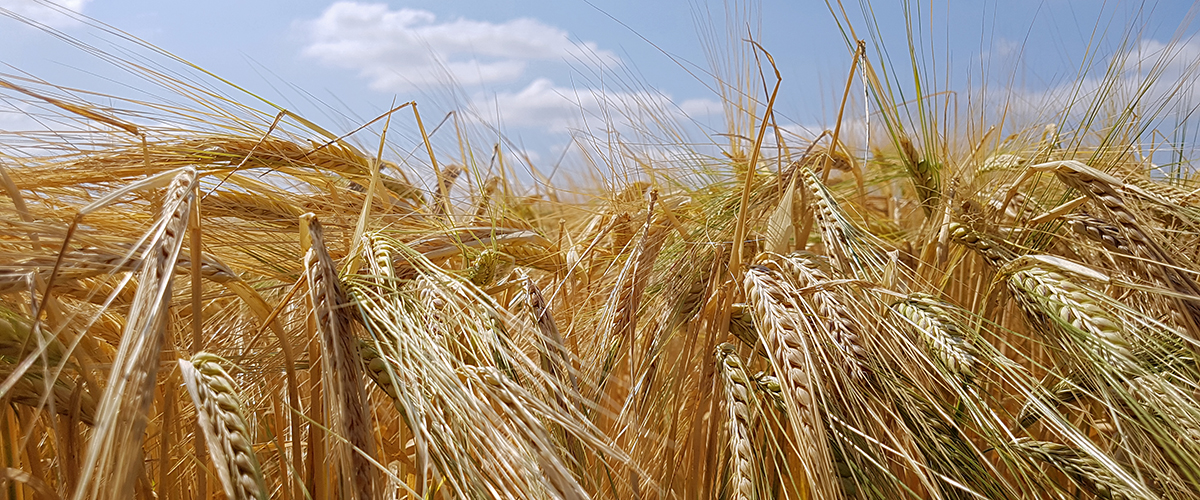
Barley proteins for human consumption
This project will investigate the protein profile using protein chemical and proteomics techniques of different barley cultivars to identify how this influences its use for human consumption
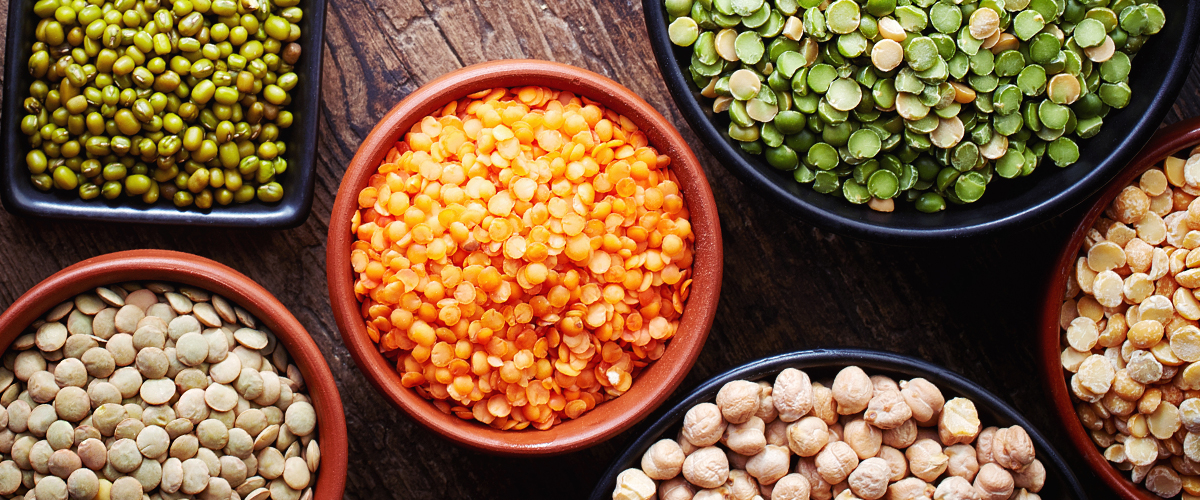
Structuring plant proteins in extruder cooling dies for the scalable mimicry of meat analogues
Engineering of animal whole muscle tissue using plant protein melts
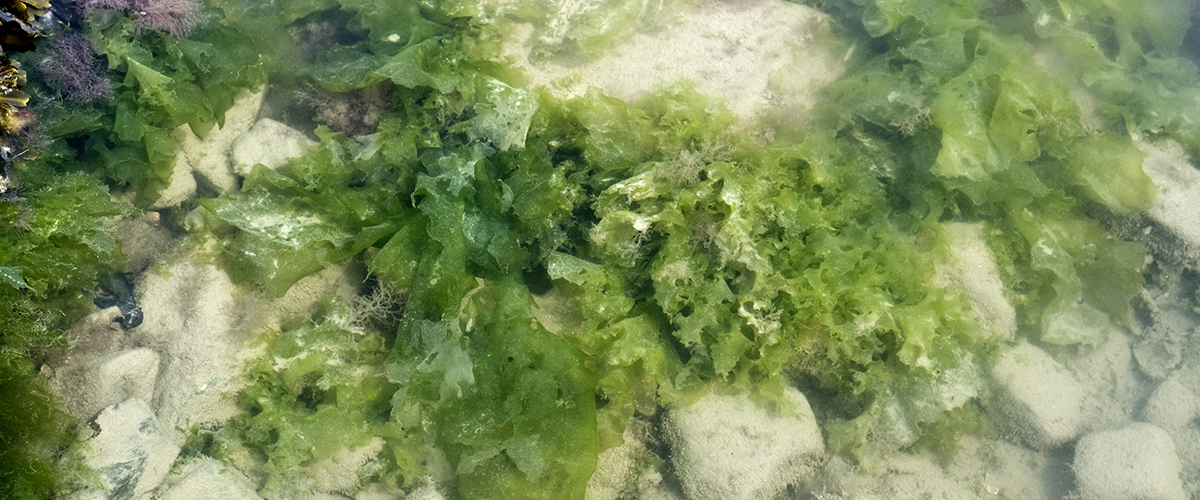
Extraction, characterization and stability of natural colorants from alfalfa and seaweed
Improving stability of colorants from green and blue biomasses
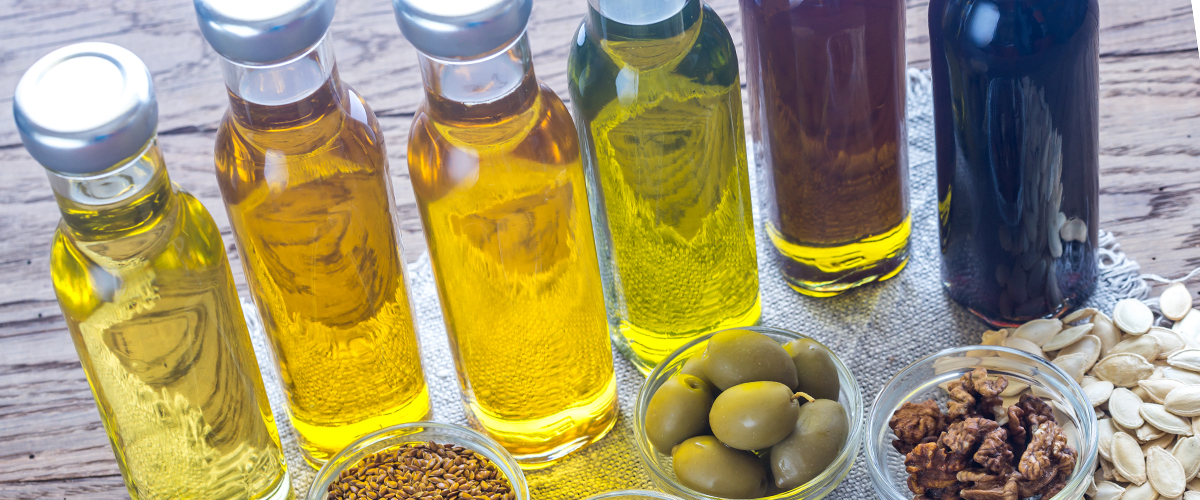
Crystallization and morphology of vegetable oils
Crystallization and morphology of vegetable oils and factors affecting these phenomena to develop green and sustainable fractionation processes for the food industry

Better bound: understanding the fate of non-covalently bounds polyphenols during human digestion
Better bound!

Nutritional value and functional properties of Faba beans
Faba beans are valuable food ingredient in a growing number of products, which calls for increasing insight into the nutritional quality and functional properties

Diglyceride removal in vegetable oil
Investigation of process conditions and efficiencies for adsorption and enzymatic hydrolysis of diglycerides in vegetable oils
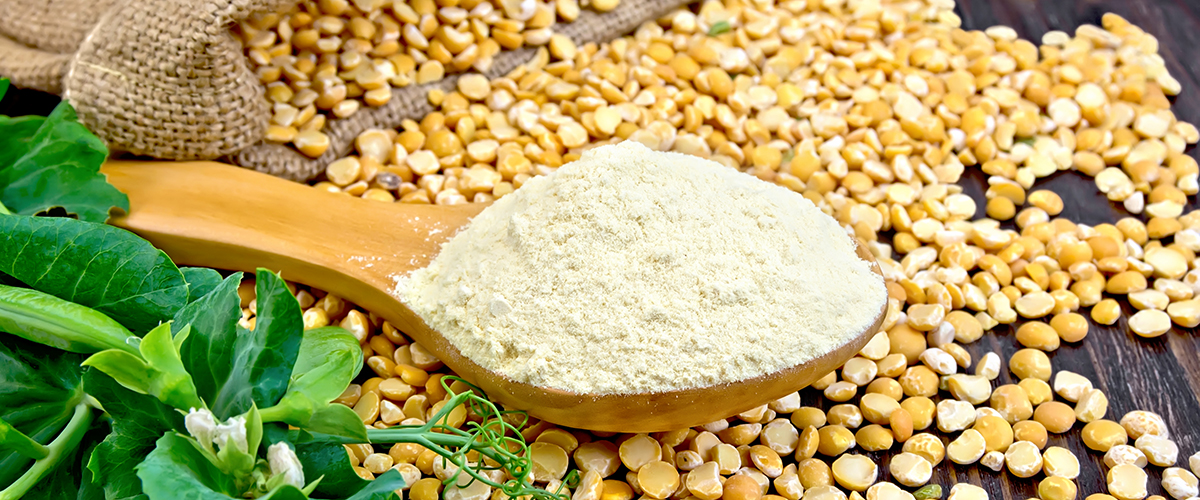
Technological improvement of dietary pea starch
Future-proofing dietary pea starch
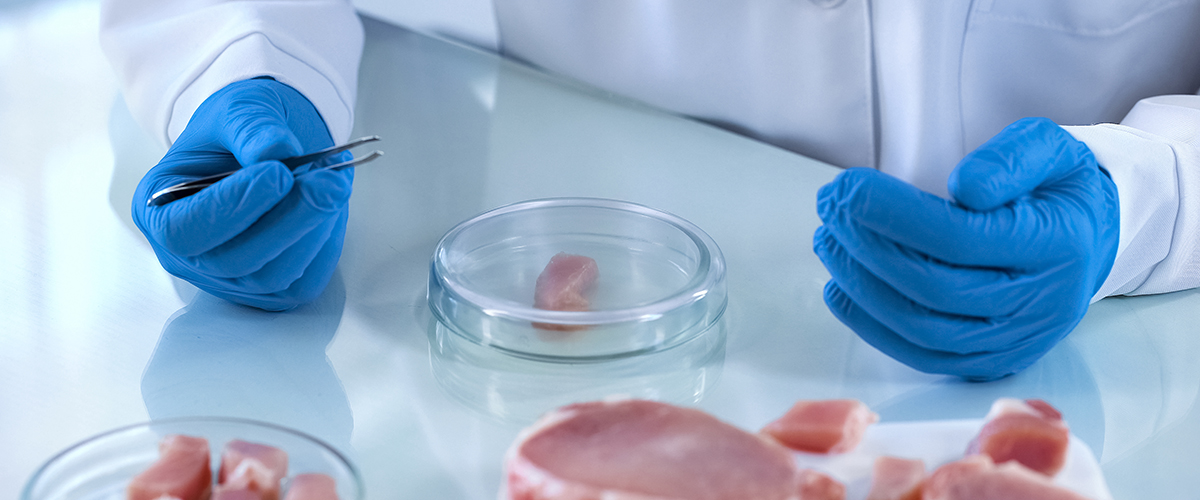
Development of Serum-free media for cultivated meat
Work with a sustainable meat production of the future. Can you develop serum-free media for cultivated meat production?

Food colloids and interfaces
The behaviour of a droplet is driven by its interface
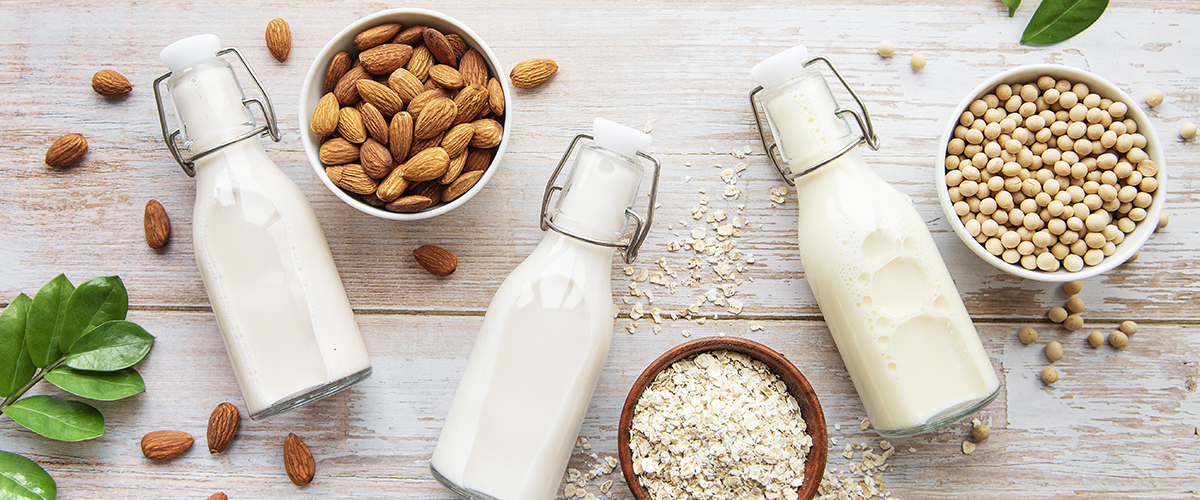
Plant based drinks: Processing parameters in a lab-scale study
Assessment of processing parameters of influence on plant-based drinks quality
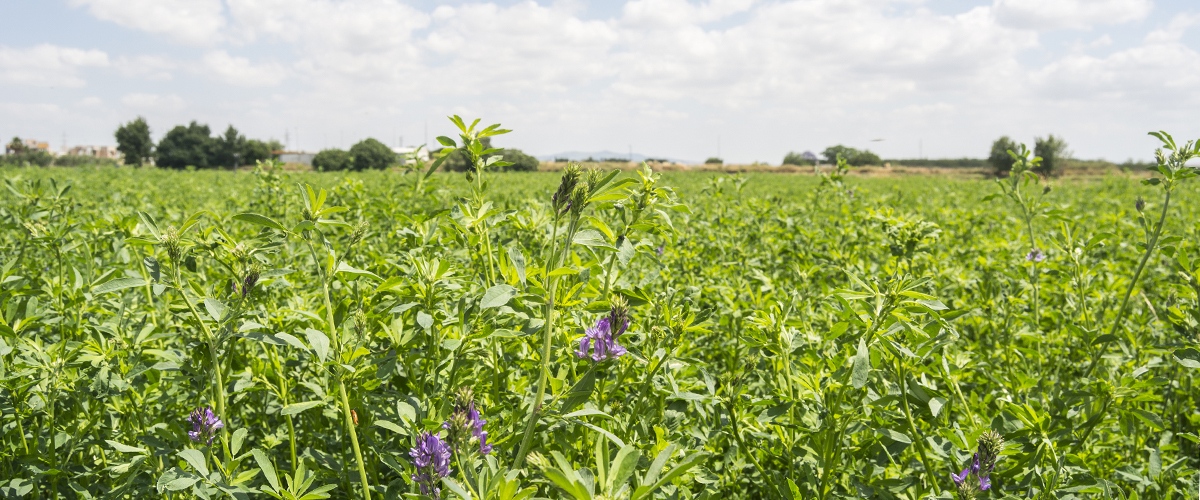
Extraction and Purification of RuBisCO for Future Food Applications
Interested in sustainable protein, processing, and functional properties? This is the project for you
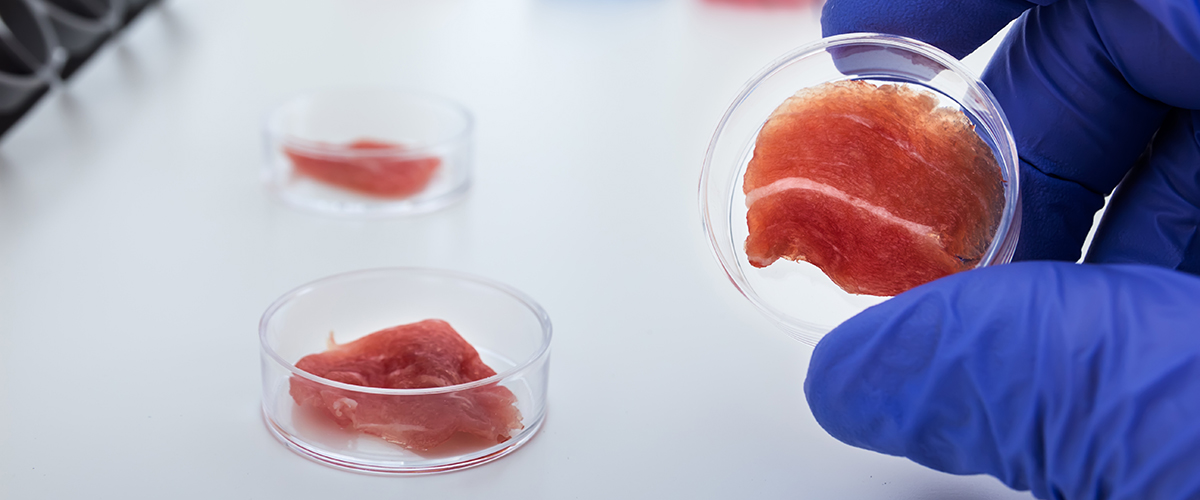
The significance of the MAPK and AMPK signalling pathways on satellite cell differentiation
How can we control cell growth for cultured meat?
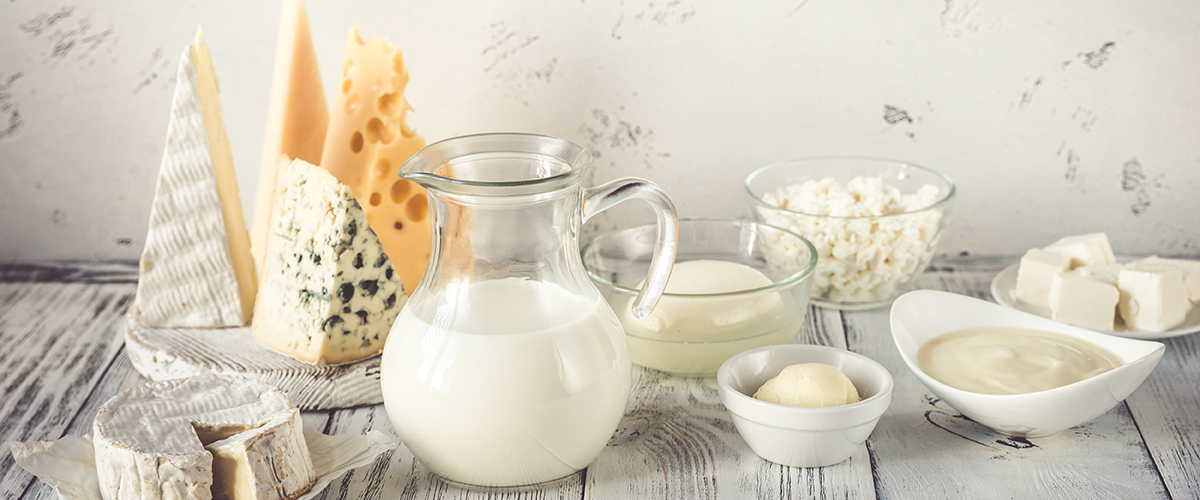
Increasing the value of milk and milk components through processing
A better understanding of how to control dairy components during processing will lead to mining value in milk
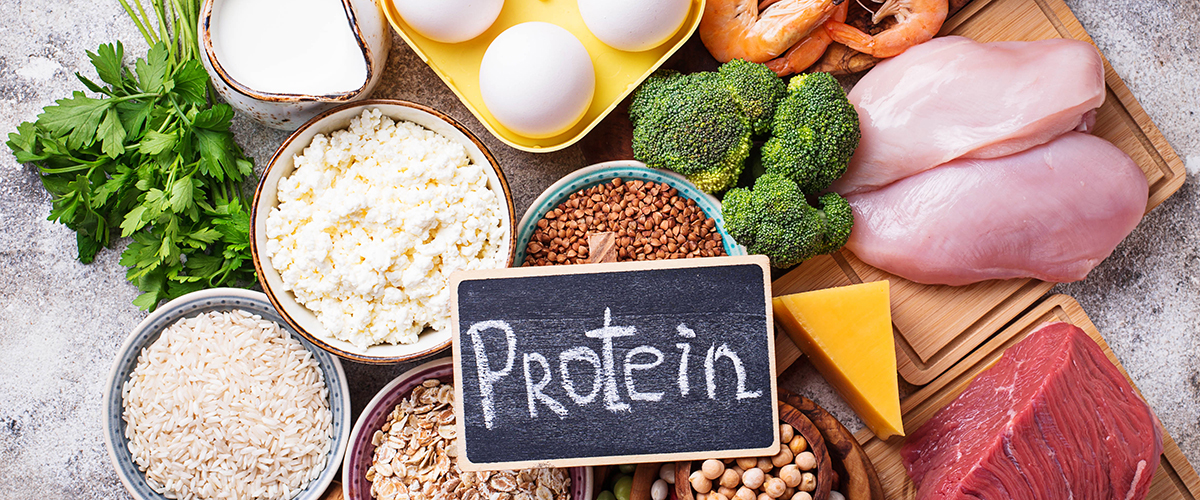
Exploring the future of hemp protein-structure and functionality
Shaping future food ingredients for a more sustainable food industry
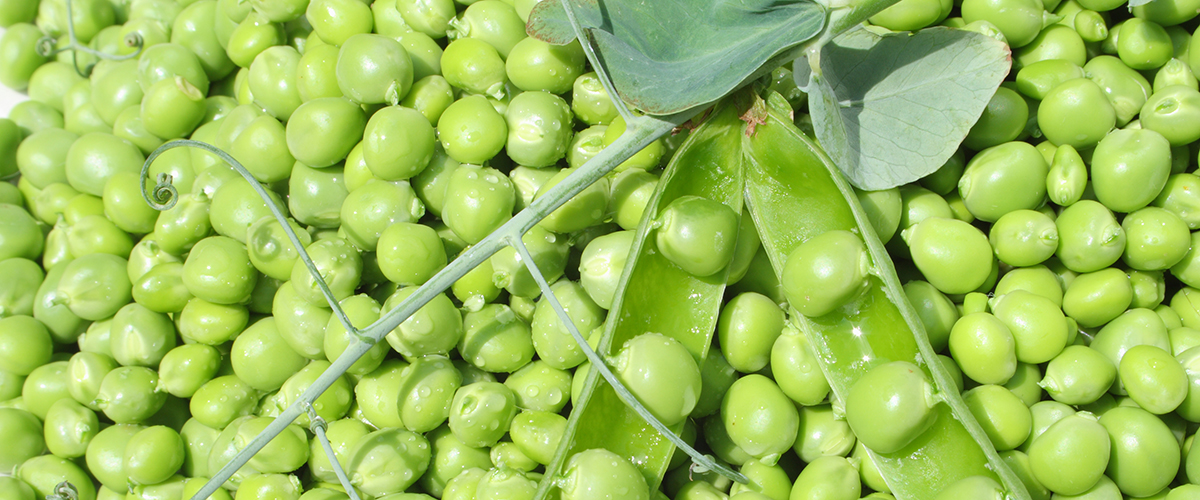
Extraction and characterization of pea protein
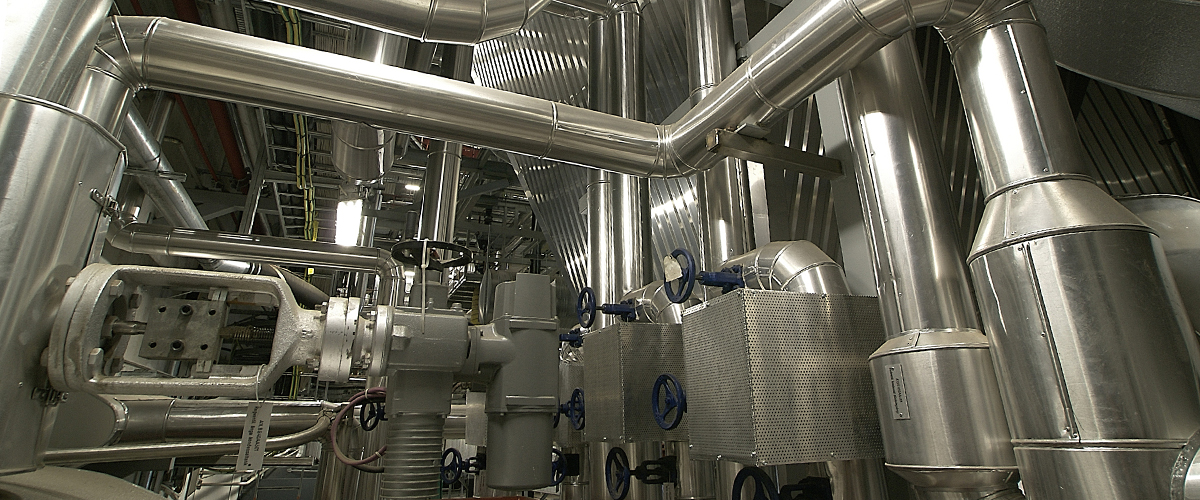
Processing future food materials
For a more sustainable food industry, better processing approaches are needed
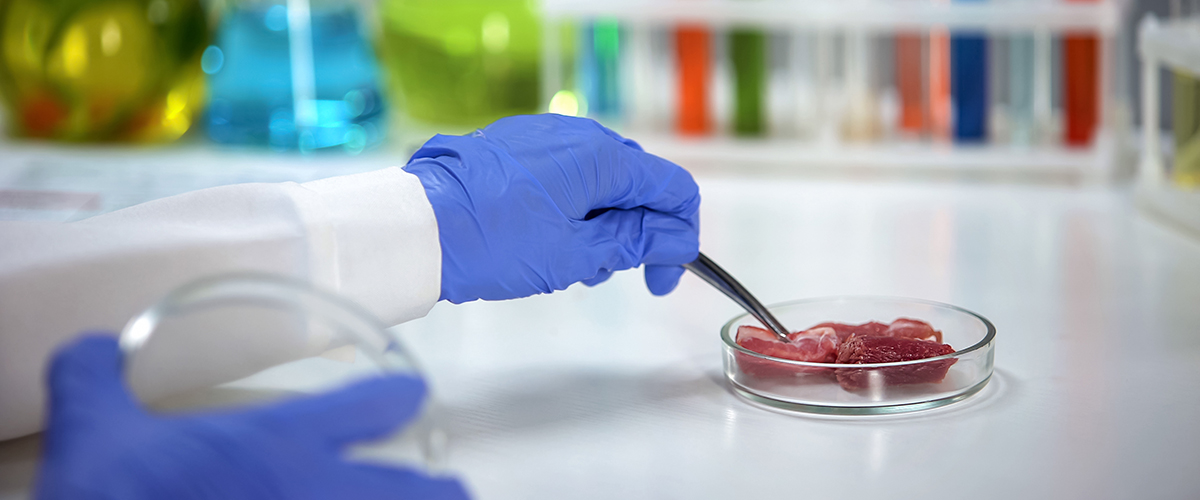
Production of cultured meat
Work with a sustainable meat production of the future. Which steps have an impact on the final composition and functionality of cultivated meat?
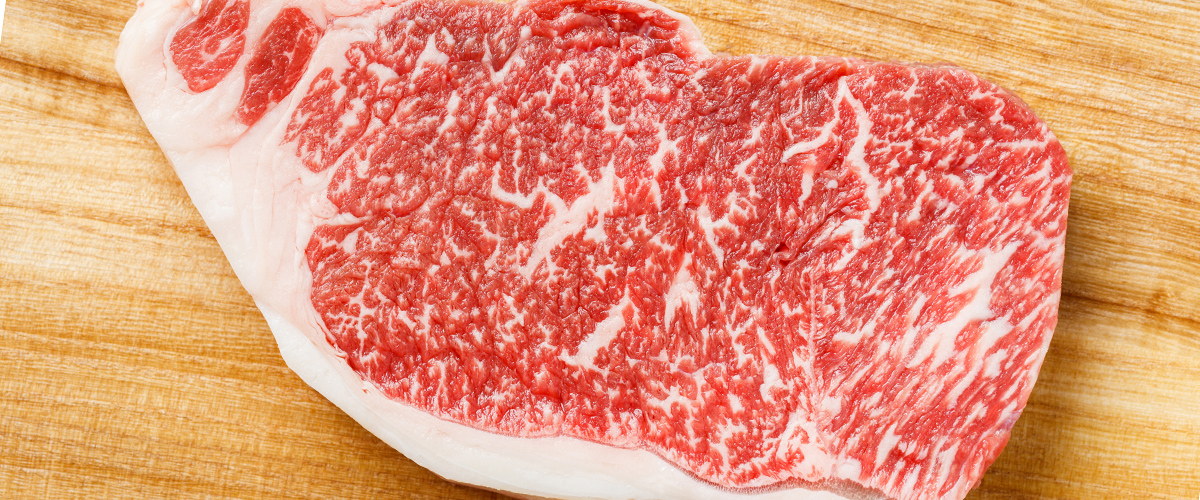
Cultivated meat in bioreactors
Take cultivated meat from lab scale to bioreactors
DigitalCommons@University of Nebraska - Lincoln
Home > Food Science and Technology > Dissertations, Theses, and Student Research
Food Science and Technology Department
Department of food science and technology: dissertations, theses, and student research.
Cellulosome-forming Modules in Gut Microbiome and Virome , Jerry Akresi
Influence of Overcooking on Food Digestibility and in vitro Fermentation , Wensheng Ding
Development of an Intact Mass Spectrometry Method for the Detection and Differentiation of Major Bovine Milk Proteins , Emily F. Harley-Dowell
Optimizing Soil Nutrient Management to Improve Dry Edible Bean Yield and Protein Quality , Emily Jundt
Fusarium Species Structure in Nebraska Corn , Yuchu Ma
Evaluating Salmonella Cross Contamination In Raw Chicken Thighs In Simulated Post-Chill Tanks , Raziya Sadat
Evaluation of Human Microbiota-Associated (HMA) Porcine Models to Study the Human Gastrointestinal Microbiome , Nirosh D. Aluthge
Differential Effects of Protein Isolates on the Gut Microbiome under High and Low Fiber Conditions , Marissa Behounek
Evaluating the Microbial Quality and Use of Antimicrobials in Raw Pet Foods , Leslie Pearl Cancio
High Pressure Processing of Cashew Milk , Rachel Coggins
Occurrence of Hydroxyproline in Proteomes of Higher Plants , Olivia Huffman
Evaluation of Wheat-Specific Peptide Targets for Use in the Development of ELISA and Mass Spectrometry-Based Detection Methods , Jessica Humphrey
Safety Assessment of Novel Foods and Food Proteins , Niloofar Moghadam Maragheh
Identification of Gut Microbiome Composition Responsible for Gas Production , Erasme Mutuyemungu
Antimicrobial Efficacy of a Citric Acid/Hydrochloric Acid Blend, Peroxyacetic Acid, and Sulfuric Acid Against Salmonella on Inoculated Non-Conventional Raw Chicken Products , Emma Nakimera
Evaluating the Efficacy of Germination and Fermentation in Producing Biologically Active Peptides from Pulses , Ashley Newton
Development of a Targeted Mass Spectrometry Method for the Detection and Quantification of Peanut Protein in Incurred Food Matrices , Sara Schlange
Molecular Mechanisms Underlying Mucosal Attachment and Colonization by Clostridioides difficile , Ben Sidner
Comparative Assessment of Human Exposure to Antibiotic-Resistant Salmonella due to the Consumption of Various Food Products in the United States , Yifan Wu
Risk-based Evaluation of Treatments for Water Used at a Pre-harvest Stage to Mitigate Microbial Contamination of Fresh Raspberry in Chile , Constanza Avello Lefno
INVESTIGATING THE PREVALENCE AND CONTROL OF LISTERIA MONOCYTOGENES IN FOOD FACILITIES , Cyril Nsom Ayuk Etaka
Food Sensitivity in Individuals with Altered and Unaltered Digestive Tracts , Walker Carson
Risk Based Simulations of Sporeformers Population Throughout the Dairy Production and Processing Chain: Evaluating On-Farm Interventions in Nebraska Dairy Farms , Rhaisa A. Crespo Ramírez
Dietary Fiber Utilization in the Gut: The Role of Human Gut Microbes in the Degradation and Consumption of Xylose-Based Carbohydrates , Elizabeth Drey
Understanding the Roles of Nutrient-Niche Dynamics In Clostridioides difficile Colonization in Human Microbiome Colonized Minibioreactors , Xiaoyun Huang
Effect of Radiofrequency Assisted Thermal Processing on the Structural, Functional and Biological Properties of Egg White Powder , Alisha Kar
Synthesizing Inactivation Efficacy of Treatments against Bacillus cereus through Systematic Review and Meta-Analysis and Evaluating Inactivation Efficacy of Commercial Cleaning Products against B. cereus Biofilms and Spores Using Standardized Methods , Minho Kim
Gut Community Response to Wheat Bran and Pinto Bean , ShuEn Leow
The Differences of Prokaryotic Pan-genome Analysis on Complete Genomes and Simulated Metagenome-Assembled Genomes , Tang Li
Studies on milling and baking quality and in-vitro protein digestibility of historical and modern wheats , Sujun Liu
The Application of Mathematical Optimization and Flavor-Detection Technologies for Modeling Aroma of Hops , Yutong Liu
Pre-Milling Interventions for Improving the Microbiological Quality of Wheat , Shpresa Musa
NOVEL SOURCES OF FOOD ALLERGENS , Lee Palmer
Process Interventions for Improving the Microbiological Safety of Low Moisture Food Ingredients , Tushar Verma
Microbial Challenge Studies of Radio Frequency Heating for Dairy Powders and Gaseous Technologies for Spices , Xinyao Wei
The Molecular Basis for Natural Competence in Acinetobacter , Yafan Yu
Using Bioinformatics Tools to Evaluate Potential Risks of Food Allergy and to Predict Microbiome Functionality , Mohamed Abdelmoteleb
CONSUMER ATTITUDES, KNOWLEDGE, AND BEHAVIOR: UNDERSTANDING GLUTEN AVOIDANCE AND POINT-OF-DECISION PROMPTS TO INCREASE FIBER CONSUMPTION , Kristina Arslain
EVALUATING THE EFFECT OF NON-THERMAL PROCESSING AND ENZYMATIC HYDROLYSIS IN MODULATING THE ANTIOXIDANT ACTIVITY OF NEBRASKAN GREAT NORTHERN BEANS , Madhurima Bandyopadhyay
DETECTION OF FOOD PROTEINS IN HUMAN SERUM USING MASS SPECTROMETRY METHODS , Abigail S. Burrows
ASSESSING THE QUANTIFICATION OF SOY PROTEIN IN INCURRED MATRICES USING TARGETED LC-MS/MS , Jenna Krager
RESEARCH TOOLS AND THEIR USES FOR DETERMINING THE THERMAL INACTIVATION KINETICS OF SALMONELLA IN LOW-MOISTURE FOODS , Soon Kiat Lau
Investigating Microbial and Host Factors that Modulate Severity of Clostridioides difficile Associated Disease , Armando Lerma
Assessment of Grain Safety in Developing Nations , Jose R. Mendoza
EVALUATION OF LISTERIA INNOCUA TRANSFER FROM PERSONAL PROTECTIVE EQUIPMENT (PPE) TO THE PLANT ENVIRONMENT AND EFFECTIVE SANITATION PROCEDURES TO CONTROL IT IN DAIRY PROCESSING FACILITIES , Karen Nieto
Development of a Sandwich ELISA Targeting Cashew Ana o 2 and Ana o 3 , Morganne Schmidt
Identification, aggressiveness and mycotoxin production of Fusarium graminearum and F. boothii isolates causing Fusarium head blight of wheat in Nebraska , Esteban Valverde-Bogantes
HIGH PRESSURE THAWING OF RAW POULTRY MEATS , Ali Alqaraghuli
Characterization and Evaluation of the Probiotic Properties of the Sporeforming Bacteria, Bacillus coagulans Unique IS-2 , Amy Garrison
Formation of Low Density and Free-Flowing Hollow Microparticles from Non-Hydrogenated Oils and Preparation of Pastries with Shortening Fat Composed of the Microparticles , Joshua Gudeman
Evaluating the Efficacy of Whole Cooked Enriched Egg in Modulating Health-Beneficial Biological Activities , Emerson Nolasco
Effect of Processing on Microbiota Accessible Carbohydrates in Whole Grains , Caroline Smith
ENCAPSULATION OF ASTAXANTHIN-ENRICHED CAMELINA SEED OIL OBTAINED BY ETHANOL-MODIFIED SUPERCRITICAL CARBON DIOXIDE EXTRACTION , Liyang Xie
Energy and Water Assessment and Plausibility of Reuse of Spent Caustic Solution in a Midwest Fluid Milk Processing Plant , Carly Rain Adams
Effect of Gallic and Ferulic Acids on Oxidative Phosphorylation on Candida albicans (A72 and SC5314) During the Yeast-to-Hyphae Transition , REHAB ALDAHASH
ABILITY OF PHENOLICS IN ISOLATION, COMPONENTS PRESENT IN SUPINA TURF GRASS TO REMEDIATE CANDIDA ALBICANS (A72 and SC5314) ADHESION AND BIOFILM FORMATION , Fatima Alessa
EFFECT OF PROCESSING ON IN-VITRO PROTEIN DIGESTIBILITY AND OTHER NUTRITIONAL ASPECTS OF NEBRASKA CROPS , Paridhi Gulati
Studies On The Physicochemical Characterization Of Flours And Protein Hydrolysates From Common Beans , Hollman Andres Motta Romero
Implementation of ISO/IEC Practices in Small and Academic Laboratories , Eric Layne Oliver
Enzymatic Activities and Compostional Properties of Whole Wheat Flour , Rachana Poudel
A Risk-Based Approach to Evaluate the Impact of Interventions at Reducing the Risk of Foodborne Illness Associated with Wheat-Based Products , Luis Sabillon
Thermal Inactivation Kinetics of Salmonella enterica and Enterococcus faecium in Ground Black Pepper , Sabrina Vasquez
Energy-Water Reduction and Wastewater Reclamation in a Fluid Milk Processing Facility , CarlyRain Adams, Yulie E. Meneses, Bing Wang, and Curtis Weller
Modeling the Survival of Salmonella in Soy Sauce-Based Products Stored at Two Different Temperatures , Ana Cristina Arciniega Castillo
WHOLE GRAIN PROCESSING AND EFFECTS ON CARBOHYDRATE DIGESTION AND FERMENTATION , Sandrayee Brahma
Promoting Gastrointestinal Health and Decreasing Inflammation with Whole Grains in Comparison to Fruit and Vegetables through Clinical Interventions and in vitro Tests , Julianne Kopf
Development of a Rapid Detection and Quantification Method for Yeasts and Molds in Dairy Products , Brandon Nguyen
Increasing Cis-lycopene Content of the Oleoresin from Tomato Processing Byproducts Using Supercritical Carbon Dioxide and Assessment of Its Bioaccessibility , Lisbeth Vallecilla Yepez
Species and Trichothecene Genotypes of Fusarium Head Blight Pathogens in Nebraska, USA in 2015-2016 , Esteban Valverde-Bogantes
Validation of Extrusion Processing for the Safety of Low-Moisture Foods , Tushar Verma
Radiofrequency processing for inactivation of Salmonella spp. and Enterococcus faecium NRRL B-2354 in whole black peppercorn and ground black pepper , Xinyao Wei
CHARACTERIZATION OF EXTRACTION METHODS TO RECOVER PHENOLIC-RICH EXTRACTS FROM PINTO BEANS (BAJA) THAT INHIBIT ALPHA-AMYLASE AND ALPHA-GLUCOSIDASE USING RESPONSE SURFACE APPROACHES , Mohammed Alrugaibah
Matrix Effects on the Detection of Milk and Peanut Residues by Enzyme-Linked Immunosorbent Assays (ELISA) , Abigail S. Burrows
Evaluation of Qualitative Food Allergen Detection Methods and Cleaning Validation Approaches , Rachel C. Courtney
Studies of Debaryomyces hansenii killer toxin and its effect on pathogenic bloodstream Candida isolates , Rhaisa A. Crespo Ramírez
Development of a Sandwich Enzyme-Linked Immunosorbent Assay (ELISA) for Detection of Macadamia Nut Residues in Processed Food Products , Charlene Gan
FROM MILPAS TO THE MARKET: A STUDY ON THE USE OF METAL SILOS FOR SAFER AND BETTER STORAGE OF GUATEMALAN MAIZE , José Rodrigo Mendoza
Feasibility, safety, economic and environmental implications of whey-recovered water for cleaning-in place systems: A case study on water conservation for the dairy industry , Yulie E. Meneses-González
Studies on asparagine in Nebraska wheat and other grains , Sviatoslav Navrotskyi
Risk Assessment and Research Synthesis methodologies in food safety: two effective tools to provide scientific evidence into the Decision Making Process. , Juan E. Ortuzar
Edible Insects as a Source of Food Allergens , Lee Palmer
IMPROVING THE UTILIZATION OF DRY EDIBLE BEANS IN A READY-TO-EAT SNACK PRODUCT BY EXTRUSION COOKING , Franklin Sumargo
Formation of Bioactive-Carrier Hollow Solid Lipid Micro- and Nanoparticles , Junsi Yang
The Influence of the Bovine Fecal Microbiota on the Shedding of Shiga Toxin-Producing Escherichia coli (STEC) by Beef Cattle , Nirosh D. Aluthge
Preference Mapping of Whole Grain and High Fiber Products: Whole Wheat Bread and Extruded Rice and Bean Snack , Ashley J. Bernstein
Comparative Study Of The D-values of Salmonella spp. and Enterococcus faecium in Wheat Flour , Didier Dodier
Simulation and Validation of Radio Frequency Heating of Shell Eggs , Soon Kiat Lau
Viability of Lactobacillus acidophilus DDS 1-10 Encapsulated with an Alginate-Starch Matrix , Liya Mo
Inactivation of Escherichia coli O157:H7 and Shiga Toxin Producing E. coli (STEC) Throughout Beef Summer Sausage Production and the use of High Pressure Processing as an Alternative Intervention to Thermal Processing , Eric L. Oliver
A Finite Element Method Based Microwave Heat Transfer Modeling of Frozen Multi-Component Foods , Krishnamoorthy Pitchai
Efficacy of Galactooliosaccharide (GOS) and/or Rhamnose-Based Synbiotics in Enhancing Ecological Performance of Lactobacillus reuteri in the Human Gut and Characterization of Its GOS Metabolic System , Monchaya Rattanaprasert
Corn Characterization and Development of a Convenient Laboratory Scale Alkaline Cooking Process , Shreya N. Sahasrabudhe
PHENOLIC RICH EXTRACTS OBTAINED FROM SMALL RED BEANS IN PREVENTING MACROPHAGE MEDIATED CHRONIC INFLAMMATION , Nidhi Sharma
Characterization and Investigation of Fungi Inhabiting the Gastrointestinal Tract of Healthy and Diseased Humans , Mallory J. Suhr
Effects of blanching on color, texture and sodium chloride content during storage time of frozen vegetable soybean modeling for commercial scale , Pimsiree Suwan
Influence of Native and Processed Cereal Grain Fibers on Gut Health , Junyi Yang
CHARACTERIZATION OF EXTRACTION METHODS TO RECOVER PHENOLIC RICH EXTRACTS FROM PINTO BEANS THAT EXERT HIGH ANTIOXIDATIVE ACTIVITIES USING RESPONSE SURFACE APPROACH , Mohammed Aldawsari
Improving the Health Impacts of Whole Grains through Processing: Resistant Starch, Dietary Fiber Solubility, and Mineral Bioaccessibility , Jennifer A. Arcila Castillo
DEBARYOMYCES HANSENII : A FOODBORNE YEAST THAT PRODUCES ANTI- CANDIDA KILLER TOXIN , Nabaraj Banjara
Characterization of Commercial Probiotics: Antibiotic Resistance, Acid and Bile Resistance, and Prebiotic Utilization , Carmen Lucia Cano Roca
Advanced Search
Search Help
- Notify me via email or RSS
- Administrator Resources
- How to Cite Items From This Repository
- Copyright Information
- Collections
- Disciplines
Author Corner
- Guide to Submitting
- Submit your paper or article
- Food Science and Technology Website
Home | About | FAQ | My Account | Accessibility Statement
Privacy Copyright
Texas A&M University Catalogs
Master of science in food science and technology.
The Master of Science (MS) degree in Food Science and Technology is designed to provide students with advanced scientific and analytical skills in broad areas of food science essential to be a successful professional in the field. The degree prepares students for advanced careers in the private sector (including new food product design and development), public policy and regulatory agencies, non-government organizations, as well as preparing them to pursue opportunities in independent research leading to a doctoral degree.
The Food Science and Technology MS provides students with a strong knowledge base in fundamental and applied aspects of food science through appropriate coursework and independent cutting-edge research that addresses current and emerging societal needs in the field. Students may pursue fundamental and/or translational (i.e. applied) research in the areas of food chemistry, food processing, food microbiology and safety including probiotic microbiology, engineering and rheology, food packaging, ingredients technology, meat or poultry science, cereals science and processing, plant bioactives, sensory analysis, etc. A process of research or study will be outlined by the student with guidance from the student’s graduate advisory committee membership.
Steps to Fulfill a Masters Program
Program Requirements
- Student's Advisory Committee
Degree Plan
- Credit Requirements
Transfer of Credit
Limitations on the use of transfer, extension and certain other courses, thesis proposal, final examination/thesis defense, final examination grading, student’s advisory committee.
After receiving admission to graduate studies and enrolling for coursework, the student will consult with the head of his or her major or administrative department (or intercollegiate faculty, if applicable) concerning appointment of the chair of his or her advisory committee. The student’s advisory committee for the MS degree will consist of no fewer than three members of the graduate faculty, representative of the student’s fields of study and research. The chair or the co-chair of the advisory committee must be from the student’s major department (or intercollegiate faculty, if applicable), and at least one or more of the members must have an appointment to a department other than the student’s major department. The outside member for students in an interdisciplinary program must have an appointment to a department different from the chair of the student’s committee.
The chair, in consultation with the student, will select the remainder of the advisory committee. The student will interview each prospective committee member to determine whether he or she is willing to serve. Only graduate faculty members located on Texas A&M University campuses may serve as chair of a student’s advisory committee. Other graduate faculty members located off campus may serve as a member or co-chair (but not chair) with a member as the chair. The chair of the committee, who usually has immediate supervision of the student’s research and thesis, has the responsibility for calling required meetings of the committee and for calling meetings at any other time considered desirable.
If the chair of a student’s advisory committee voluntarily leaves the University and the student is near completion of the degree and wants the chair to continue to serve in this role, the student is responsible for securing a current member of the University Graduate Faculty, from the student’s academic program and located near the Texas A&M University campus site, to serve as the co-chair of the committee. The Department Head or Chair of Intercollegiate faculty may request in writing to the Associate Provost and Dean of the Graduate and Professional School that a faculty member who is on an approved leave of absence or has voluntarily separated from the university, be allowed to continue to serve in the role of chair of a student’s advisory committee without a co-chair for us to one year. The students should be near completion of the degree. Extensions beyond the one year period can be granted with additional approval of the Dean.
If the chair of the student’s advisory committee is unavailable for an extended time in any academic period during which the student is involved in activities relating to an internship, thesis or professional paper, and is registered for courses such as 684, 691, 692 or 693, the student may request, in writing, that the department head appoint an alternate advisory committee chair during the interim period.
The duties of the committee include responsibility for the proposed degree plan, the research proposal, the thesis and the final examination. In addition, the committee as a group and as individual members are responsible for advising the student on academic matters, and, in the case of academic deficiency, initiating recommendations to the Graduate and Professional School.
The committee members’ approval on the degree plan indicate their willingness to accept the responsibility for guiding and directing the entire academic program of the student and for initiating all academic actions concerning the student. Although individual committee members may be replaced by petition for valid reasons, a committee cannot resign en masse.
The student’s advisory committee, in consultation with the student, will develop the proposed degree plan. The degree plan must be completed and filed with the Graduate and Professional School prior to the deadline imposed by the student’s college or interdisciplinary degree program, if applicable, and no later than 90 days prior to the date of the final oral examination or thesis defense.
A student should submit the degree plan using the online Document Processing Submission System .
A student submitting a proposed degree plan for a Master of Science degree should designate on the official degree plan the appropriate program option.
Additional coursework may be added to the approved degree plan by petition if it is deemed necessary by the advisory committee to correct deficiencies in the student’s academic preparation. No changes can be made to the degree plan once the student’s Request for Final Examination or Request for Final Examination Exemption is approved by the Graduate and Professional School.
Credit Requirement
A minimum of 32 semester credit hours of approved courses and research is required for the thesis option Master of Science degree.
Ordinarily the student will devote the major portion of their time to work in one or two closely related fields. Other work will be in supporting fields of interest.
A student who has earned 12 hours of graduate credit in residence at Texas A&M University may be authorized to transfer courses in excess of the limits prescribed below upon the advice of the advisory committee and with the approval of the Graduate and Professional School. Courses taken in residence at an accredited U.S. institution or approved international institution with a final grade of B or greater may be considered for transfer credit if, at the time the courses were completed, the courses would be accepted for credit toward a similar degree for a student in degree-seeking status at the host institution. Otherwise, the limitations stated in the following section apply. Coursework in which no formal grades are given or in which grades other than letter grades (A or B) are earned (for example, CR, P, S, U, H, etc.) is not accepted for transfer credit. Courses appearing on the degree plan with grades of D, F or U may not be absolved by transfer work. Credit for thesis research or the equivalent is not transferable. Credit for coursework submitted for transfer from any college or university must be shown in semester credit hours or equated to semester credit hours. An official transcript from the university at which the transfer coursework was taken must be sent directly to the Office of Admissions.
Courses used toward a degree at another institution may not be applied for graduate credit. If the course to be transferred was taken prior to the conferral of a degree at the transfer institution, a letter from the registrar at that institution stating that the course was not applied for credit toward the degree must be submitted to the Graduate and Professional School.
Grades for courses completed at other institutions are not included in computing the GPA.
Some departments may have more restrictive requirements for transfer work. If otherwise acceptable, certain courses may be used toward meeting credit-hour requirements for the master’s degree under the following limitations.
- Graduate and/or upper-level undergraduate courses taken in residence at an accredited U.S. institution, or approved international institution with a final grade of B or greater will be considered for transfer credit if, at the time the courses were completed, the student was in degree-seeking status at Texas A&M University, or the student was in degree-seeking status at the institution at which the courses were taken; and if the courses would be accepted for credit toward a similar degree for a student in degree-seeking status at the host institution.
- Courses previously used for another degree are not acceptable for degree plan credit.
- The maximum number of credit hours taken in post-baccalaureate non-degree (G6) classification at Texas A&M University which may be considered for application to the degree plan is 12.
A zero credit 684 or 685 course is only allowed for non-thesis option master's students. A zero credit 681 course can be used for either thesis or non-thesis option master’s students. Other courses, including 691 (Research) hours, are not eligible for zero credit.
- Not more than 8 hours in the combination of 691 (research), 684 (Professional Internship), or SOPH 680 may be used. Under normal circumstances, non-thesis masters students may not use 691 hours on their degree plan. However, for non-thesis masters students who are using 691 hours on the degree plan, see the Non-Thesis Option section on the Program Requirements page in the graduate catalog for the degree they are pursuing.
- Not more than 8 hours of 685 (Directed Studies) may be used.
- Not more than 3 hours of 690 (Theory of Research) may be used.
- Not more than 3 hours of 695 (Frontiers in Research) may be used.
- A maximum of 2 hours of 681 (Seminar).
- A maximum of 9 hours of advanced undergraduate courses (300- or 400-level).
- For graduate courses of three weeks’ duration or less, taken at other institutions, up to 1 hour of credit may be obtained for each five-day week of coursework. Each week of coursework must include at least 15 contact hours.
- Continuing education courses may not be used for graduate credit.
- Extension courses are not acceptable for credit.
For non-distance degree programs, no more than 50 percent of the non-research coursework required for the program may be completed through distance education courses.
To receive a graduate degree from Texas A&M University, students must earn one-third or more of the credits through the institution’s own direct instruction. This limitation also applies to joint degree programs.
Exceptions will be permitted only in unusual cases and when petitioned by the student’s advisory committee and approved by the Graduate and Professional School.
Thesis Option
An acceptable thesis is required for the Master of Science degree for a student who selects the thesis option program. The finished work must reflect a comprehensive understanding of the pertinent literature and express in clear English, the problem(s) for student, the method, significance, and results of the student’s original research. Thesis formatting must be acceptable to the Graduate and Professional School as outlined in the Guidelines for Theses, Dissertations, and Records of Study.
After successful defense (or exemption) and approval by the student’s advisory committee and the head of the student’s major department (or chair of intercollegiate faculty, if appropriate), the student must submit the thesis in electronic format as a single PDF file to https://etd.tamu.edu/ . Additionally, a thesis approval form with original signatures must be received by the Graduate and Professional School through the Academic Requirements Completion System (ARCS). Both the PDF file and the completed approval form must be received by the deadline.
Deadline dates for submitting the thesis are announced each semester or summer term in the “Graduate and Professional School Calendar” (see Time Limit statement). These dates also can be accessed via the Graduate and Professional School website .
Each student who submits a manuscript for review is assessed a one-time thesis/dissertation processing fee through Student Business Services. This processing fee is for the thesis/dissertation services provided. After commencement, theses and dissertations are digitally stored and made available through the Texas A&M Libraries.
A thesis that is deemed unacceptable by the Graduate and Professional School because of excessive corrections will be returned to the student’s department head (or chair of the intercollegiate faculty, if applicable) . The manuscript must be resubmitted as a new document, and the entire review process must begin again. All original submittal deadlines must be met during the resubmittal process to graduate.
For the thesis option Master of Science degree, the student must prepare a thesis proposal for approval by the advisory committee and the head of the major department or chair of the interdisciplinary faculty, if applicable. This proposal must be submitted to the Graduate and Professional School at least 20 working days prior to the submission of the request for the final examination.
Compliance issues must be addressed if a graduate student is performing research involving human subjects, animals, infectious biohazards and recombinant DNA. A student involved in these types of research should check with the Office of Research Compliance and Biosafety at (979) 458-1467 to address questions about all research compliance responsibilities. Additional information can also be obtained on the Office of Research Compliance and Biosafety website.
A student must pass a final examination by dates announced each semester or summer term in the Graduate and Professional School Calendar . To be eligible to take the final examination, a student’s GPA must be at least 3.000 for courses on the degree plan and for all courses completed at Texas A&M which are eligible to be applied to a graduate degree, and there must be no unabsolved grades of D, F or U for any course listed on the degree plan. To absolve a deficient grade, the student must repeat the course at Texas A&M University and achieve a grade of C or better. All coursework on the degree plan must have been completed with the exception of those hours for which the student is registered. For thesis-option students, an approved thesis proposal must be on file in the Graduate and Professional School according to published deadlines prior to the final examination or submission of the request for exemption from the final examination.
A request to schedule the final examination must be submitted to the Graduate and Professional School via ARCS a minimum of 10 working days in advance of the scheduled date for the examination. The Graduate and Professional School will be notified via ARCS of any cancellations. A student may be given only one opportunity to repeat the final examination for the master’s degree and that must be within a time period that does not extend beyond the end of the next regular semester (Summer terms are excluded).
For thesis option students, the final examination covers the thesis and all work taken on the degree plan and at the option of the committee may be written or oral or both. The final examination may not be administered before the thesis is available to all members of the student’s advisory committee in substantially final form, and all members have had adequate time to review the document. The examination is conducted by the student’s advisory committee as finally constituted. A thesis option student must be registered at the University in the semester or summer term in which the final examination is taken. Persons other than members of the graduate faculty may, with mutual consent of the candidate and the major professor, attend final examinations for advanced degrees. Upon completion of the questioning of the candidate, all visitors must excuse themselves from the proceedings. A positive vote by all members of the graduate committee with at most one dissension is required to pass a student on his or her exam. A department, or interdisciplinary degree program, may have a stricter requirement provided there is consistency within all degree programs within a department or interdisciplinary degree program.
The student’s advisory committee will conduct this examination. The student’s department will promptly report the results of the Final Examination to the Graduate and Professional School via the Academic Requirements Completion System (ARCS) within 10 working days of completion of the final examination. If an approved committee member substitution (one only) has been made, their approval must be submitted to the Graduate and Professional School via ARCS.
If the program requires the advisory committee to include at least one external member – with an appointment to a department other than the student’s major department – and the substitution is for the sole external member of the advisory committee, then the substitute must also be external to the student’s major department. In extenuating circumstances, with approval of the Graduate and Professional School, an exception to this requirement may be granted.
A thesis option candidate may petition to be exempt from the final examination provided the degree plan GPA is 3.500 or greater and he/she has the approval of the advisory committee, the head of the student’s major department, or intercollegiate chair, if appropriate, and the Graduate and Professional School. It is required that the petition for exemption be submitted the same semester the student intends to submit the thesis.
Additional Requirements
Continuous registration, foreign languages, application for degree.
In partial fulfillment of the residence requirement for the degree of Master of Science, the student must complete 9 resident credit hours during one regular semester or one 10-week summer semester in resident study at Texas A&M University. A minimum of 1 credit hour must be in a non-distance education delivery mode. Semesters during which the student is enrolled in all distance education coursework will not count toward fulfillment of the residence requirement. Upon recommendation of the student’s advisory committee, department head or Chair of the Interdisciplinary Program, if appropriate, and with approval of the Graduate and Professional School, a student may be granted exemption from this requirement. Such a petition, however, must be approved prior to the student’s registration for the final 9 credit hours of required coursework.
Students who are employed full-time while completing their degree may fulfill total residence requirements by completion of less-than-full time course loads each semester. In order to be considered for this, students are required to submit a Petition for Waivers and Exceptions along with verification of their employment to the Graduate and Professional School.
See Residence Requirements .
A student in the thesis option of the Master of Science program who has completed all coursework on his/her degree plan other than 691 (Research) is required to be in continuous registration until all requirements for the degree have been completed.
See Continuous Registration Requirements .
All degree requirements must be completed within a period of seven consecutive years for the degree to be granted. A course will be considered valid until seven years after the end of the semester in which it is taken. Graduate credit for coursework which is more than seven calendar years old at the time of the final examination (oral or written) may not be used to satisfy degree requirements.
A student who has chosen the thesis option must have the final corrected copies of the thesis cleared by the Graduate and Professional School within one year of the semester in which the final exam is taken, or a final exam exemption petition was approved. Exams taken in between terms will expire at the end of the term that ended prior to the exam. For example, a final exam taken and passed during the Fall 2022 semester will expire at the end of the Fall 2023 semester. A final exam taken in the time between the Summer and Fall 2022 semesters will expire at the end of the Summer 2023 semester.
No specific language requirement exists for the Master of Science degree.
For information on applying for your degree, please visit the Graduation section.
ScholarWorks@UMass Amherst
Home > CNS > FOODSCI > FOODSCI_DISS
Food Science Department Dissertations Collection
Dissertations from 2024 2024.
TASTE DYSFUNCTION AND CANCER: CLINICIANS AND PATIENT PERSPECTIVES AND EXPERIENCES , Lakmani Tharaka Galaniha, Food Science
ANALYSIS OF MICRO(NANO)PLASTICS IN FOOD USING RAMAN MICROSCOPY , xin guo, Food Science
DEVELOPMENT OF A NOVEL NANOPORE-BASED SENSING TECHNOLOGY FOR NOROVIRUS DETECTION , Minji Kim, Food Science
Uric acid degrading bacteria in the gut: A promising strategy to control hyperuricemia , William W. Wolfe IV, Food Science
Dissertations from 2023 2023
Analysis of antioxidant synergism and its mechanisms in different food systems , Ipek Bayram, Food Science
Bifidobacterial Metabolism of Fucosylated Human Milk Oligosaccharides Influences Structure and Function of the Infant Gut Microbiome , Liv R. Dedon, Food Science
THE ROLE OF EUBACTERIUM LIMOSUM IN THE METABOLISM AND HEALTH IMPACTS OF METHYLATED DIETARY COMPONENTS , Jingyuan Huang, Food Science
UNDERSTANDING AND DEVELOPING SAFER SANITATION AGENTS AND STRATEGIES IN FOOD PRODUCTION ENVIRONMENTS , Pragathi Kamarasu, Food Science
Detection and control of environmentally transmissible viruses , Anand R. Soorneedi, Food Science
Investigation Of Dietary Plant Compounds: Pharmacokinetics and Potential Applications , Galaxie Story, Food Science
Understanding and Controlling the Effects of Dietary and Viral Factors on Intestinal Health and Allergy , Cassandra Suther, Food Science
INHIBITION OF COLONIC INFLAMMATION BY EDIBLE SEAWEEDS , Lingxiao Yi, Food Science
Dissertations from 2022 2022
Novel Approaches for Preventing Lipid Oxidation in Emulsion-Based Food Systems , Mitchell D. Culler, Food Science
ANALYSIS OF FOOD COLORANTS USING RAMAN SPECTROSCOPY , Haochen Dai, Food Science
BIFIDOBACTERIUM LONGUM SUBSP. INFANTIS UTILIZATION OF HUMAN MILK NITROGEN IS LINKED TO CARBOHYDRATE METABOLISM , Shuqi Li, Food Science
DOUBLE EMULSIONS RELEVANT TO FOOD SYSTEMS: FABRICATION, CHARACTERIZATION, AND APPLICATIONS , Jinning Liu, Food Science
FOOD NANOEMULSIONS ENHANCE BIOAVAILABILITY OF LIPOPHILIC NUTRACEUTICALS , Haiyan Luo, Food Science
DETECTION OF MYCOTOXINS USING SURFACE-ENHANCED RAMAN SPECTROSCOPY , Lourdes B. Martinez Rojas, Food Science
Enhancement in Photoinactivation of Food-borne Pathogenic Bacteria with the Use of Curcumin and Surfactants , Victor Ryu, Food Science
MAPPING SELECTED POLYPHENOLS METABOLISM BY GUT BACTERIA AND THEIR GENES , Ermin Zhao, Food Science
Dissertations from 2021 2021
Interactions between Titanium Dioxide Nanoparticles (NPs) and mucin , . Boimin, Food Science
INFLUENCE OF MOLECULAR EXCHANGE PROCESSES ON THE FATE OF EMULSIFIED LIPID NANOPARTICLES IN OIL-IN-WATER EMULSIONS , Songran Gao, Food Science
Antibiotic Sensitivity Testing of Foodborne Bacteria Using Surface-Enhanced Raman Spectroscopy , Joshua Gukowsky, Food Science
Microbiota-mediated metabolism of curcumin in the gastrointestinal tract and its implications in anti-colitis , Zhengze Li, Food Science
FORMATION, CHARACTERIZATION, AND UTILIZATION OF MULTILAYER NANOEMULSIONS IN FOODS , Jorge L. Muriel Mundo, Food Science
INVESTIGATION ON THE FACTORS IMPACTING THE BIOACCESSIBILITY OF OIL-SOLUBLE VITAMINS: FOOD MATRIX EFFECTS , Yunbing Tan, Food Science
USING CAENORHABDITIS ELEGANS AS THE IN VIVO MODEL TO STUDY FOOD BIOACTIVES AND ENVIRONMENTAL POLLUTANTS , Yiren Yue, Food Science
DIETARY AND ENVIRONMENTAL RISK FACTORS OF COLONIC INFLAMMATION AND COLON CANCER , Jianan Zhang, Food Science
IMPROVEMENT OF SOLUBILITY, STABILITY, AND BIOACCESSIBILITY OF CURCUMIN USING COLLOIDAL DELIVERY SYSTEMS , bingjing zheng, Food Science
GASTROINTESTINAL FATE OF ORGANIC AND INORGANIC NANOPARTICLES IN FOODS , Hualu Zhou, Food Science
Dissertations from 2020 2020
Effects of Tempeh Fermentation on Soy Free and Bound Phenolics: Release, Transformation, and Stimulated Production , Amadeus Driando Ahnan, Food Science
Coffee Bioactives Regulate Lipid Metabolism in Caenorhabditis elegans , Renalison Farias Pereira, Food Science
PROMOTION OF COLON HEALTH BY STRAWBERRY AND CRANBERRY , Yanhui Han, Food Science
Design and Fabrication of Colloidal Delivery Systems to Encapsulate and Protect Curcumin: An Important Hydrophobic Nutraceutical , Mahesh Kharat, Food Science
ANALYSIS OF TITANIUM DIOXIDE NANOPARTICLES IN FOODS USING RAMAN SPECTROSCOPIC TECHNIQUES , Janamkumar Pandya, Food Science
Investigate the Interactions between Silver Nanoparticles and Leafy Vegetables Using Surface Enhanced Raman Spectroscopic Mapping Technique , Zhiyun Zhang, Food Science
Dissertations from 2019 2019
PREDICTION AND CONTROL OF VITAMIN C LOSS IN SPACEFLIGHT FOODS , William Dixon, Food Science
DEVELOPMENT OF FILTER-BASED SERS MAPPING METHODS FOR RAPID IDENTIFICATION AND DETECTION OF BACTERIA , Siyue Gao, Food Science
Determining Kinetic Parameters of Thiamine Degradation in Three NASA Spaceflight Foods in Thermal Processing and Long-Term Storage AND Methods for Analyzing Microstructure and Precipitant Development in Real and Model Wines , Timothy R. Goulette, Food Science
Surface-enhanced Raman Spectroscopic Imaging of Bacteria within Fresh Produce In Situ , Michael Hickey, Food Science
THE CATALYTIC UREASE SUBUNIT UREC IS CRITICAL FOR BIFIDOBACTERIUM LONGUM UREA UTILIZATION , YANG LYU, Food Science
DIETARY OLIGOSACCHARIDES ARE DIFFERENTIALLY METABOLIZED BY COMMENSAL MICROBIOTA WITHIN IN VITRO MODEL SYSTEMS , Ezgi Özcan, Food Science
THE POTENTIAL HEALTH EFFECTS OF BLUEBERRY (VACCINIUM CORYMBOSUM L.) , CHE PAN, Food Science
THE BIOACTIVE EFFECTS OF CHICORIC ACID AS A FUNCTIONAL FOOD INGREDIENT , Ye Peng, Food Science
Effects of Ivermectin and Perfluorobutanesulfonic Acid (PFBS) on Lipid Metabolism , Weipeng Qi, Food Science
SILVER MIRROR SUBSTRATE AND ROLLING METHOD FOR IMPROVED SURFACE-ENHANCED RAMAN SPESCTROSCOPIC ANALYSIS IN FOOD , Yanqi Qu, Food Science
STRATEGIES TO INCREASE LIPID OXIDATIVE STABILITY OF A LOW MOISTURE CRACKER SYSTEM , Thanh Vu, Food Science
CYTOCHROME P450 MONOOXYGENASE-MEDIATED LIPID METABOLISM IN OBESITY AND COLON TUMORIGENESIS , Weicang Wang, Food Science
HUMAN MILK NON-PROTEIN NITROGEN METABOLISM BY INFANT ASSOCIATED BIFIDOBACTERIA , Xiaomeng You, Food Science
ENHANCING NUTRACEUTICALS BIOAVAILABILITY BY NANOEMULSION-BASED DELIVERY AND EXCIPIENT SYSTEMS , Ruojie Zhang, Food Science
DEVELOPMENT OF COLLOIDS-BASED FOOD DELIVERY SYSTEMS TO ENHANCE THE BENEFICIAL EFFECTS OF NUTRACEUTICALS FOR HUMAN HEALTH , zipei zhang, Food Science
Dissertations from 2018 2018
Interaction of Titanium Dioxide Nanoparticles (NPs) with Food Components and Mechanistic Studies of Adverse Effects Induced by Titanium Dioxide NPs , Xiaoqiong Cao, Food Science
APPLICATIONS OF DROSOPHILA MELANOGASTER IN FOOD SCIENCE RESEARCH , Phoebe Beverly Chen, Food Science
Combination Regimens Using Dietary Components For The Chemoprevention Of Colorectal Cancer and Inflammation , Christina DiMarco-Crook, Food Science
THE HEAT SHOCK COGNATE 70 PROTEIN (HSC70) IS A NOVEL TARGET FOR NOBILETIN IN COLON CANCER CELLS , Zili Gao, Food Science
INTERACTION BETWEEN DIETARY COMPONENTS AND GUT MICROBIOTA AND ITS IMPLICATION IN BIOACTIVITIES AND METABOLISM IN COLON , Min Gu, Food Science
BIOTRANSFORMATION OF RESVERATROL AND ITS IMPLICATIONS IN BIOLOGICAL ACTIVITIES IN THE COLON , Fang Li, Food Science
A LIVING MODEL FOR OBESITY AND AGING RESEARCH: CAENORHABDITIS ELEGANS , PEIYI SHEN, Food Science
MODULATION OF HEPATIC LIPID METABOLISM BY INSECTICIDES AND FOOD BIOACTIVES , Jason Yang, Food Science
IN SITU AND REAL-TIME MONITORING AND CHARACTERIZATION OF PESTICIDE RESIDUES ON AND IN FRESH PRODUCE USING SERS , Tianxi Yang, Food Science
Dissertations from 2017 2017
UTILIZATION OF NATURAL EMULSIFIERS AND THEIR DERIVATIVES TO FORMULATE EMULSION-BASED DELIVERY SYSTEMS FOR HYDROPHOBIC NUTRACEUTICALS , cansu gumus, Food Science
UNDERSTANDING THE IMPACT OF OXYGEN CONCENTRATION AND ACTIVE PACKAGING ON CONTROLLING LIPID OXIDATION IN OIL-IN-WATER EMULSIONS , David Johnson, Food Science
POTENTIAL ENHANCEMENT OF DIETARY ISOTHIOCYANATES COMBINATION ON BIOLOGICAL ACTIVITIES , Kanyasiri Rakariyatham, Food Science
Lung and Colon Cancer Chemoprevention by Polymethoxyflavones , Mingyue Song, Food Science
IMIDACLOPRID, A NEONICOTINOID INSECTICIDE, IMPAIRS LIPID AND GLUCOSE METABOLISM , Quancai Sun, Food Science
BIOTRANSFORMATION OF POLYMETHOXYFLAVONES AND ITS IMPLICATION ON BIOLOGICAL ACTIVITIES , Minqi Wang, Food Science
EFFECTS OF PERMETHRIN, A PYRETHROID INSECTICIDE, ON GLUCOSE AND LIPID METABOLISM , XIAO XIAO, Food Science
Dissertations from 2016 2016
Bacteriophage: Bioengineered Bacterial Detection and Applications , Samuel D. Alcaine, Food Science
Chemopreventive Effects of Cranberry in Association with the Alteration of Gut Microbiota , xiaokun cai, Food Science
Bacteriophage-Based Colorimetric Detection of Escherichia Coli in Drinking Water , Juhong Chen, Food Science
Functionalized Electrospun Nanofibers for Food Science Applications , Minhui Dai, Food Science
Optimization of the fabrication, stability, and performance of food grade nanoemulsions with low and high energy methods , Jennifer Komaiko, Food Science
Advanced Materials for Rapid Diagnostics in Food, Agriculture and Healthcare , Charmaine K.W. Koo, Food Science
Novel Advancements for Improving Sprout Safety , Kyle S. Landry, Food Science
Label-free and Aptamer-based Surface Enhanced Raman Spectroscopy for Detection of Food Contaminants , Shintaro Pang, Food Science
Synthesis and Applications of Non-migratory Metal Chelating Active Packaging , Maxine J. Roman, Food Science
Development of Bacteriophage Based Detection Technique for Food Safety and Environment Monitoring , Ziyuan Wang, Food Science
Enzyme Stabilization in Hierarchical Biocatalytic Food Packaging and Processing Materials , Dana Erin Wong, Food Science
Chemopreventive Effects of Polymethoxyflavones , Xian Wu, Food Science
Characterizing Colorectal Cancer Cells and Their Interactions with Polymethoxyflavones by Raman Microscopy , Hua Zhang, Food Science
Dissertations from 2015 2015
Layer-by-Layer Antimicrobial N-Halamine Polymer Coatings for Food Contact Materials , Luis J. Bastarrachea Gutierrez, Food Science
Fabrication, Characterization and Biological Fate of Phytochemical Delivery System , Jingjing Chen, Food Science
Pro- and Antioxidant Effects of Phospholipids on Lipid Oxidation in Bulk Oil , Leqi Cui, Food Science
Effects of Conjugated Linoleic Acid (CLA) on Skeletal Muscle Metabolism , YOO KIM, Food Science
Physicochemical And Toxicological Assessment Of Antimicrobial ε-Polylysine-Pectin Complexes , Cynthia L. Lopez Pena, Food Science
Biotransformation of Polymethoxyflavones by Gut Microbiome and Molecular Characterization of Polymethoxyflavones by Surface Enhanced Raman Spectroscopy , Changchu Ma, Food Science
Structural Design Approaches for Creation of Reduced Fat Products , Bicheng Wu, Food Science
THE CHEMOPREVENTIVE EFFECT OF POLYMETHOXYFLAVONES: TARGETING THE COLORECTAL CANCER STEM CELLS , Fei Xu, Food Science
RATIONALIZING NANOEMULSION FORMATION FOR ENCAPSULATION, PROTECTION AND DELIVERY OF BIOACTIVE FOOD COMPONENTS , Ying Yang, Food Science
ROLE OF LIPID-BASED DELIVERY SYSTEMS IN THE BIOLOGICAL FATE OF LIPOPHILIC NUTRACEUTICALS AND INORGANIC NANO-PARTICLES IN THE GASTROINTESTINAL TRACT , Mingfei Yao, Food Science
Dissertations from 2014 2014
Susceptibility of Escherichia Coli O157:h7, Salmonella Enterica Sp., and Listeria Monocytogenes to Antimicrobial Mixed Micelle Delivery Systems , Chanelle N. Adams, Food Science
Understanding Lipid Oxidation in Low-Moisture Food , Leann M. Barden, Food Science
INFLUENCE OF LIPOTEICHOIC ACID ON LISTERIA MONOCYTOGENES BIOFILM FORMATION AND CELLULAR STRESS , Imelda T. Brooks, Food Science
Development of capillary-driven microfludic biosensors for food safety and quality assurance , Fei He, Food Science
IMPACT OF SURFACE ACTIVE MINOR COMPONENTS ON PHYSICOCHEMICAL PROPERTIES OF ASSOCIATION COLLOIDS AND LIPID OXIDATION IN BULK OIL , Ketinun Kittipongpittaya, Food Science
Cancer Chemoprevention by Dietary Compounds Targeting Angiogenesis , Wasamon Nutakul, Food Science
Dissertations from 2013 2013
Lactic Acid Bacteria Mediated Phenolic Bioactive Modulation From Fruit Systems For Health Benefits , Chandrakant Ankolekar, Food Science
Surface Modification of Food Contact Materials for Processing and Packaging Applications , Jeffrey Alan Barish, Food Science
Inhibition of Lung Carcinogenesis by Polymethoxyflavones , Noppawat Charoensinphon, Food Science
Designing Novel Emulsion Performance by Controlled Hetero-Aggregation of Mixed Biopolymer Systems , Yingyi Mao, Food Science
Advanced Search
- Notify me via email or RSS
- Collections
- Disciplines
Author Corner
- Login for Faculty Authors
- Faculty Author Gallery
- Expert Gallery
- University Libraries
- Food Science Website
- UMass Amherst
This page is sponsored by the University Libraries.
© 2009 University of Massachusetts Amherst • Site Policies
Privacy Copyright
- Visit the University of Nebraska–Lincoln
- Apply to the University of Nebraska–Lincoln
- Give to the University of Nebraska–Lincoln
Search Form
Master of science with thesis option in food science and technology.

Master of Science Degree with Thesis Option consists of original research that contributes to new knowledge. It is designed to prepare students for careers in research. Students go on to doctoral degree programs or hired as scientists, technologists, and development positions in industry, laboratories and government agency.
Annual Progress Report and Supervisory Committee Meeting – complete at least once a year Annual Progress Report (Word) At least two weeks before their supervisory committee meeting, students need to email the completed Student Progress Report form to their supervisory committee members and FDST Graduate Coordinator. It is your responsibility to call meetings with your committee. Supervisory Committee – complete by end of 2nd semester M.S. Supervisory Committee Departmental Form (Word) Requirements
- Minimum of three committee members
- Faculty advisor from the Department of Food Science and Technology serves as chair
- At least two must be Food Science and Technology faculty. The third member may be from Food Science and Technology or another department.
- If pursuing a minor: required to have a graduate faculty member from the minor program on their Supervisory Committee
Memorandum of Courses – complete by end of 2nd semester or before completion of 15 credit hours Memorandum of Course OGS Form (Word)
Plan of Study Calculation Spreadsheet (Excel) Minimum of 30 semester credit hours
- At least one-half (15 hours), including thesis credits, must be in Food Science and Technology (FDST)
- Minimum of 8 credit hours must be 800 or 900 level without 400-level counterparts (excludes FDST 899)
- 6-10 hours of FDST 899 Master Thesis credit hours
- Minimum of 1 credit hour of FDST 896-002 Teaching Assistant
- Minimum of 1 credit hour of FDST 951 Seminar
- Minimum of 1 credit hour of FDST 952 Professional Communication
Research Proposal Defense – complete by the end of 3rd semester or before completion of 20 credit hours Proposal Defense Evaluation Form (PDF)
Proposal Defense Summary Form (PDF) Written Research Proposal Requirements
- Written format as a grant proposal for USDA, NIH, or NSF - Proposal length is recommended to be 6 to 7 pages
- Sections of a grant proposal can be included, but not limited to: Project Summary or Abstract, Project Narrative or Description, Bibliography and References
Oral Research Proposal Defense Requirements
- 20-minute seminar presentation with Supervisory Committee members
- Followed by oral examination by the Supervisor Committee
Final Semester and Graduation Please follow the Office of Graduate Studies (OGS) Steps to Completion in order to meet OGS deadlines and complete the necessary forms. Applying for Graduation Graduation Application Thesis and Final Oral Defense Final Examination Report OGS Form Written Requirements Office of Graduate Studies Written Format Guidelines Oral Defense
45-minute public seminar presentation with 10 minutes for questions, open to faculty, graduate students, and guests; followed by oral examination by the Supervisor Committee (please allow 2 hours) Last Day and Departure Checklist Departure and Offboarding Checklist (Word) Submit a departure checklist before you leave UNL to Julie McManamey, FDST Graduate Program Coordinator. Your last day for FIC building access is commencement day. If you are on a graduate assistantship, your last workday is commencement day.
Chapman University Digital Commons
Home > Dissertations and Theses > Food Science (MS) Theses
Food Science (MS) Theses
Below is a selection of dissertations from the Food Science program in Schmid College that have been included in Chapman University Digital Commons. Additional dissertations from years prior to 2019 are available through the Leatherby Libraries' print collection or in Proquest's Dissertations and Theses database.
Theses from 2024 2024
A Meta-Analysis of Seafood Species Mislabeling Rates in the United States , Sarah Ahles
Use of a Novel Combination of Multiplex PCR and DNA Barcoding in Assessing Authenticity of Ginseng Products , Diane Kim
Optimization of Pre-Enrichment and Screening Methods for the Detection of Salmonella enterica in Meat Analog Products , Kylie Sacapano
Chlorogenic and Caffeic Acids’ Impact on Formation of Fluorescent and Non-Fluorescent Advanced Glycation End-Products as a Function of Temperature , Christianne Yapor
Theses from 2023 2023
Kinetic and Mass Spectrometric Characterization of Anti-Greening Mechanisms of Cysteine and Glutathione in Chlorogenic Acid-Lysine Solutions , Charles Taylor Drucker
DNA Barcoding of Ayurvedic Herbal Supplements used for the Purported Treatment of COVID-19 , Calin Harris
Disinfection of Foodborne Bacteria using the Contamination Sanitization Inspection and Disinfection (CSI-D) Device , Jennifer McCoy Sanders
Labeling Compliance, Species Authentication, and Short-Weighting of Prepackaged Frozen Shrimp Sold in Grocery Stores in Southern California , McKenna Rivers
Single-Laboratory Validation for the Detection of Salmonella enterica in Meat Analog Products , Amanda Tabb
Theses from 2022 2022
Characterization of Gangliosides and Fatty Acids in Extracellular Vesicles from Human Milk , Aliya Amin
Evaluating Mislabeling of Raw, Ready-To-Eat Seafood Products in Orange County, California , Courtney Kitch
Microbiological Safety and Quality of Raw, Ready-to-Eat (RTE) Seafood Sold in Orange County, California , Grace Marquis
Investigating the Relation Between Genetic Variation in FADS1 & FADS2 with the LCPUFA Content of Extracellular Vesicles from Human Milk , Natalie Paterson
Theses from 2021 2021
The Impact of Processing on the Content and Composition of Bovine Milk Extracellular Vesicles , Anna Colella
Gamma and X-ray Irradiation Improve Postharvest Shelf-Life in 'Bartlett' Pears , Matthew Garcia
Color and Structural Modifications of Alkaline Extracted Sunflower Protein Concentrates and Isolates Using L-Cysteine and Glutathione , Akira Ishii
Microplate Immunocapture Coupled with LAMP-BART and Selective Plating for the Rapid Detection of Salmonella Infantis in Dry Dog Food and Treats , Danielle Rosen
Application of a DNA Mini-Barcoding System based on the Mitochondrial Control Region for the Identification of Raw and Processed Tuna Products , Jiahleen Roungchun
Assessing the Efficacy of Bacteriological Analytical Manual (BAM) Enrichment Broths for Detection of Salmonella spp. in Meat Analogs , Georgia Sampson
Theses from 2020 2020
Formation of Maillard Reaction Products and Chlorogenic Acid-Quinone Induced Green Pigments in Gluten-Free Pretzels Made Using Sunflower Flour , Rashi Bhatnagar
Elucidating the Relation between Human Milk Fatty Acids, Extracellular Vesicles, and Infant Developmental Outcomes in the First Year of Life , Diana Bickmore
Effect of Dried Mushroom Powder on Thiol Content in Lyophilized and Native Bovine Myofibrillar Protein , Allany Chayasing
Use of Molecular Methods to Authenticate Animal Species and Tissue in Bovine Liver Dietary Supplements , Olive Dahm
Oyster Mushroom (Pleurotus ostreatus) Stipe Peptides as in-vitro Radical Scavenging, Ferrous Iron Chelating, & Ferric Reducing Antioxidant Compounds , Suraj Meharwade
Effect of Low Dose Irradiation on Expression of Genes Involved in Ethylene Biosynthesis of 'Granny Smith' Apples , Brian Nyakundi
Labeling Compliance, Species Authentication and Net Weight Identification of Frozen Fish Fillets Sold in Grocery Stores in Southern California , April Peterson
Authentication of Species in Bison Products Using Molecular Methods , Zerika Scales
Impact of Gamma Irradiation on Post-harvest Disorders in 'Bartlett' Pears , Michelle Tu
Theses from 2019 2019
Effect of Poor Sanitation Procedures on Cross-Contamination of Animal Species in Ground Meat Products , Sunjung Chung
Use of Gamma Irradiation as an Intervention Treatment to Inactivate Escherichia coli O157:H7 in Freshly Extracted Apple Juice , Dielle Aurelia Fernandes
Real-Time PCR Combined with DNA Barcoding for the Authentication of Red Snapper (Lutjanus campechanus) Fillets , Rachel Isaacs
L-Cysteine Effects on Chlorogenic Acid Quinone-Amino Acid Induced Greening and Browning: Mechanism and Effects on Antioxidant Capacity , Yundi Liang
Labeling Compliance and Species Authentication of Fish Fillets Sold at Grocery Stores in Southern California , Priscila Liou
Use of PCR Cloning Combined with DNA Barcoding to Identify Fish in a Mixed-Species Product , Anthony Silva
Theses from 2015 2015
Identification of Species in Ground Meat Products Sold on the U.S. Commercial Market Using DNA-Based Methods , Dawn Kane
Antimicrobial Susceptibility of Listeria monocytogenes to Bacteriophage LISTEX™ P100 in Alfalfa Sprouts (Medicago sativa) , Tushar Sawant
- Collections
- Disciplines
Advanced Search
- Notify me via email or RSS
Author Corner
- Submit Research
- Rights and Terms of Use
- Leatherby Libraries
- Chapman University
ISSN 2572-1496
Home | About | FAQ | My Account | Accessibility Statement
Privacy Copyright
Master of Food Technology

I have always been passionate about teaching food science, especially when the focus is sensory analysis.
Koushik Adhikari, Ph.D.
Application Deadlines
News & events, testimonials, contact information, request information.
Offered online through the College of Agricultural and Environmental Sciences , the University of Georgia’s online Master of Food Technology will teach you how to maximize in-line processing efficiencies, improve food product quality and safety and implement good manufacturing practices in line with current regulations, food safety, and HAACP practices.
This fully online, non-thesis master’s provides working professionals the opportunity to learn from food industry experts and top food science and technology researchers. The Master of Food Technology degree offers the opportunity for instruction in core areas of food technology, such as processing, packaging, microbiology, fermentation, chemistry, ingredients, product development, and food regulation. In addition, the degree offers current and up-to-date information on emerging trends, new regulations, and potential innovations. You will learn identification and prevention of product failure, an understanding of the consumer mind and consumer needs, innovation in process optimization for consistent quality and safety, new product formulations to improve human health, and fermentation technology used in the beverage industry.
Whether your bachelor’s degree is in food science, chemistry, biology, nutrition, chemical engineering, environmental sciences, or other science-related fields, the Master of Food Technology will prepare you for a rewarding career in the food industry. Program graduates accept jobs such as Research & Development Director/Innovation, Manager of Quality Assurance, Quality Assurance Auditor, Executive R&D Chef, Senior Process Engineer, Manager of Ingredients, and Manager of Sales.
Accreditations
The University of Georgia is accredited by the Southern Association of Colleges and Schools Commission on Colleges (SACSCOC) to award baccalaureate, master’s, specialist, and doctoral degrees. The University of Georgia also may offer credentials such as certificates and diplomas at approved degree levels. Questions about the accreditation of the University of Georgia may be directed in writing to the Southern Association of Colleges and Schools Commission on Colleges at 1866 Southern Lane, Decatur, GA 30033-4097, by calling (404) 679-4500, or by using information available on SACSCOC’s website ( www.sacscoc.org ).
Credit and Transfer
Total Hours Required to Earn Degree: 33 (credit hours)
Maximum Hours Transferable into Program: 6
Master of Food Technology Degree Program Admission Requirements
Students applying to The University of Georgia must be accepted by the Graduate School . Persons holding a bachelor’s degree from any institution accredited by the proper regional accrediting association are eligible to apply for admission to the Graduate School.
Two years of work experience in the food industry or food-related occupation in the public sector is recommended for admission to this graduate program.
Master of Food Technology Application Checklist
- Application – Submit the Graduate School Admissions online. Application fee: $75 Domestic/$100 International.
- Select Campus – Online
- Select Intended Program – MFT, Food Technology (Food Science and Technology) [MFT_FTEC_ONL]
- Résumé or curriculum vita – Submit online to the Graduate School.
- Statement of Purpose – Submit a one-two page statement of purpose online to the Graduate School. The statement of intent should clarify the candidate’s relevant background, interests, and goals in relation to the program.
- Transcripts – Submit unofficial transcripts from all institutions attended as part of the online application. Send official transcripts after you are offered admission.
- Letters of Recommendation – Submit three letters of recommendation online to graduate school. Letters should be from individuals who can evaluate the applicant’s scholarly ability and potential for success in a graduate program. Preferably at least two of them are from faculty who have instructed the applicant in a previous program of study. The application will prompt your recommenders to submit their letters electronically.

Domestic Applicants
- Fall: July 1 – While applications received prior to April 1 receive priority consideration, the program will review all competitive applications received before July 1.
- Spring: November 15
- Summer: May 1
International Applicants
- Fall: April 15
- Spring: October 15
- Summer: February 15
- International Applicants – must submit TOEFL or IELTS scores.
Master of Food Technology Tuition & Fees
Tuition rates and student fees can change each year.
Based on 2022 credit hour cost, a person completing this program at the recommended pace would have paid $20,757 in tuition .
Please use the Estimated Cost Calculator on the Bursar’s Office website to calculate one academic (Fall/Spring) year’s current tuition.
This program is an E-Rate program, so choose “yes” for the E-Rate line item within the calculator.
Online students pay the following fees: Connect UGA, Green, and Technology. The total for those fees in the fall semester of 2022 was $147 for students enrolled in exclusively online courses.
Potential additional costs include textbooks, exam proctoring fees, and technology upgrades.
The complete cost of attendance can be found at https://osfa.uga.edu/costs/ .
Financial Aid
Visit the Office of Student Financial Aid for information about financial assistance.
Corporate Assistance
Consult your employer about the availability of tuition reimbursement or tuition assistance programs.
Military Assistance
Active duty military, veterans, and military families should visit Veterans Educational Benefits to take full advantage of available financial assistance and educational benefits.
University System of Georgia Tuition Assistance Program (TAP)
The purpose of TAP is to foster the professional growth and development of eligible employees. For more information, see Tuition Assistance (refer to the Distance Learning section).
Technology Requirements
- Computer with current operating system (Windows, Mac, or Linux). Additional peripherals such as webcam, headphones, and microphone are required.
- High-speed internet access.
Master of Food Technology Degree Program Structure
The Master of Food Technology degree program is fully online and consists of at least 33 semester hours. A student working full-time can complete the program in 2.5 – 3 years depending on the number of courses taken per semester. An advisor and graduate committee will work with you to design a program of study that meets your professional needs.
The exit project exposes students to comprehensive literature research and provides training in problem-solving and exhaustive analysis of a current topic in food science. At the end of the course work and exit project, students in the non-thesis master’s program will take a comprehensive final written and oral exam developed by the advisor and a graduate committee. Entrance requirements are the same as those for the Master of Food Technology degree. This is a professional degree program and will not meet the criteria for admission to the Ph.D. program in Food Science and Technology.
Master of Food Technology Area Courses and Electives
33 Semester Hours Required (6 hours required, 12 hours from Area courses, plus 15 hours of elective courses)

Laurel Dunn Assistant Professor and Extension Specialist

Anand Mohan Associate Professor

Faith Critzer Associate Professor
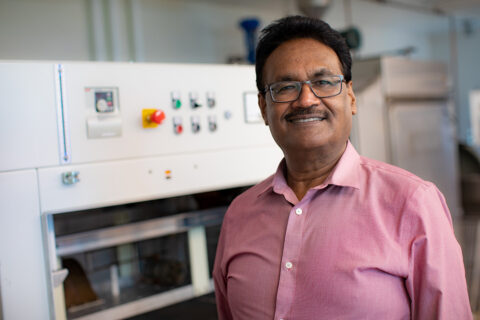
Rakesh K. Singh Professor

Abhinav Mishra, Ph.D. Assistant Professor

Chad Paton, Ph.D. Associate Professor

William Kerr, Ph.D. Professor
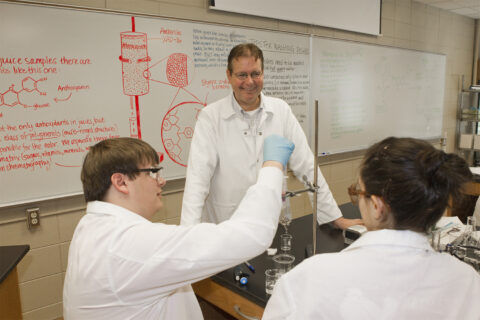
Ron Pegg, Ph.D. Josiah Meigs Distinguished Teaching Professor

Koushik Adhikari, Ph.D. Associate Professor
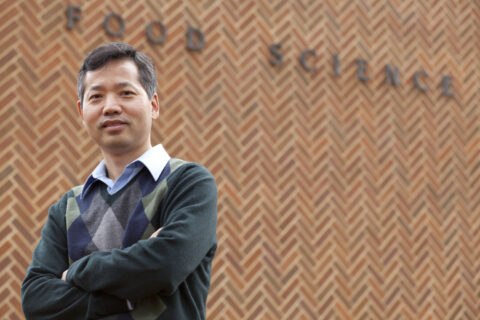
Fanbin Kong, Ph.D. Professor
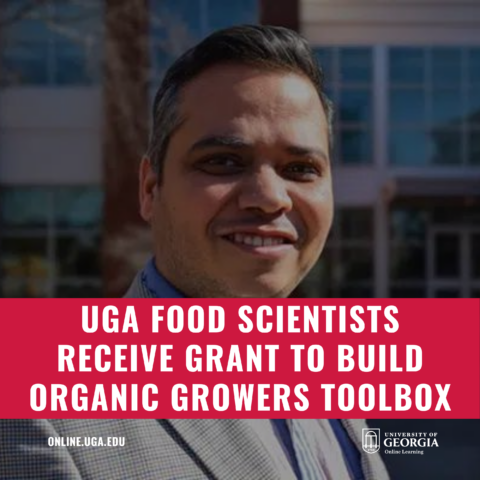
UGA Food Scientists Receive Grant to Build Organic Growers Toolbox
Abhinav Mishra, associate professor in the Department of Food Science and Technology – as well as faculty member and graduate program coordinator in the online Master of Food Technology program – has received a $3.5 million grant, alongside his colleague, Govindaraj Dev Kumar, as part of their ongoing work in food safety.
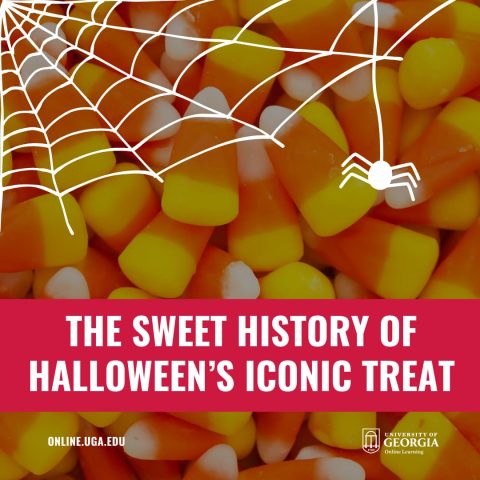
The Sweet History of Halloween’s Iconic Treat
Candy corn may be the most controversial treat of the fall season. You either think of the tri-colored candy with nostalgic feelings or you are put off by its waxy texture or the sweet flavor. Whatever your opinions on the candy are, you probably do not immediately think of its…
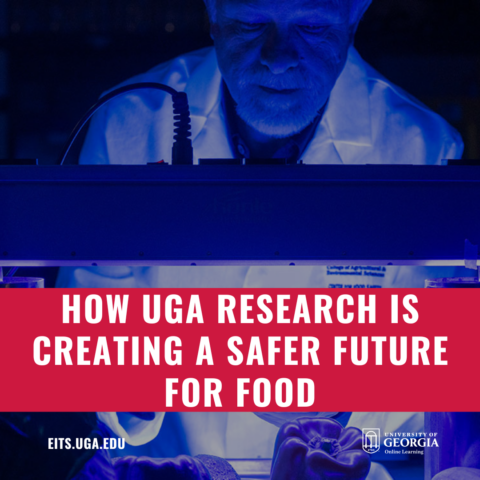
How UGA Research is Creating a Safer Future for Food
The University of Georgia Center for Food Safety is making strides to create a safer global food chain. Each year around 48 million people in the U.S. get sick from contaminated food or beverages and 3,000 die from foodborne illness. The center houses a team of scientists dedicated…
See more news articles related to this program
“I was excited to be among a network of peers who were similarly interested in this niche world of learning about how food is made and how to make it better. I knew that was something I wanted to be a part of. The reputation of UGA has opened so many doors for me, led me to meet incredible friends during college, and allowed me to connect with our alumni networks far and wide.” Zane Tackett , ’20
“When I meet with customers I now have a broader understanding of how they are processing their products which helps me to ask better questions, so I can understand the issues they are facing and I am able to make suggestions to improve their product or save them money. The online Master of Food Technology degree made me a more valuable employee to the company I work for and opened doors for more advancements in my career.” David Gill ,’ 20
“The professors in the Food Technology program were highly knowledgeable with impressive credentials and they were very accessible.” Paul Rockwell ,’11
Contact us using the request for information form or call 706-480-8438 .
Request Info
By submitting this form, you authorize the University of Georgia (UGA) to store the information you have provided on this form. You also authorize UGA to contact you by text message or phone call regarding your inquiry, including by automated texting or calling using the information you have provided on this form. If you provide additional phone numbers including wireless phone numbers to UGA, you also authorize UGA to use those numbers to contact you via any of the aforementioned methods. If you do not want your information stored, please email [email protected].
This site uses cookies.
If you have any questions please email us at [email protected] ..

Home > Theses and Dissertations > Dissertations > BROWSE_DISSERTATIONS > DISSERTATIONS_FOODTECH
Food Technology
Theses from 2023 2023.
Delineating the Impact of Vascular Smooth Muscle Cell ABCA1/G1 And Mir-33A Expression on Atherosclerosis , Olanrewaju Oladosu
Theses from 2022 2022
The Effect of Freezing Rates and Storage on Atlantic Salmon and Peaches , Wesam Aljeddawi
Theses from 2021 2021
360-Degree Analysis of the Produce Prescription (Rx) Program , Joel Hamilton
Theses from 2019 2019
Fat-Soluble Vitamins in Dietary Supplements: Optimization of Extraction, Simultaneous Determination by HPLC And Stability Studies , Yaqi Wang
Theses from 2018 2018
Evaluation of Animal Manure-based Compost as an Environmental Source of Clostridium difficile , Muthu Dharmasena
The Effects of Various Retort Motions on the Rate of Heat Penetration of a Food Simulant in Pouches , Mollye MacNaughton
A Practical Guide to Eye Tracking Using Qualitative and Quantitative Means , Julie Christine Rice
Development of a Database-Driven Management System for Retail Food Packaging Eye Tracking Studies , Mengmeng Zhao
Theses from 2017 2017
Exploring School-Level Factors Associated with Student Participation in the National School Lunch Program , Jermaine Jacob Shaw
Characterization of Volatile and Non-Volatile Compounds and Classification of Different Cultivars of Chinese Ziziphus jujuba Mill. Fruits , Lina Wang
Theses from 2016 2016
Microbiological and Quality Characteristics of Alfalfa (Medicago sativa) and Mung Bean (Vigna radiata) Sprouts Grown Using Different Water Sources and Treated Post-Harvest , Kimberly A. Baker
Examination of Infographics-Based Reusable Learning Objects (RLO) and Traditional Didactic Lectures (TDL) to Improve Consumer Knowledge and Perceptions about the Safe Use of Plastic Food Containers in a Microwave Oven , Najla Ahmed Khateeb
Study of Chemical Profiles of Volatile and Non-Volatile Bioactive Compounds of Muscadine Grapes (Vitis rotundifolia) During Ripening Stages and Evaluation of Their In Vitro Biological Properties , Bolim Lee
Formulation and Characterization of an Antimicrobial Coating Containing Nisin for Large Scale Food Package Converting Processes , Michele Christine Perna
Evaluating Indirect Calorimetry Methodology, Postural Energy Expenditure, and the Effects of Diet and Exercise Recommendations , Collin Jeffrey Popp
Spatial Analysis of the Nutritional Risk of Older Adults Participating in the Older Americans Act Program in South Carolina, 2013 , Maciel Ugalde
Theses from 2015 2015
Application of an Andragogical Approach and Experiential Learning for Teaching Culinary Nutrition to Culinary Arts Students , Nisreen Mohamad Abdulsalam
NUTRITION EDUCATION FOR CHILDREN ATTENDING PRESCHOOL (NECAP) , Ibtehal Alsallaiy
Development and Implementation of the Generations Eating Together Through Cooking (G.E.T.T. Cooking) Curriculum and Its Effects on an Inter-generational Population: A Pilot Study , Elizabeth Ramirez
Web-Based Nutrition Education Intervention for African American Women Using the Theory of Planned Behavior , Joyce Senior Angulo
EFFECTS OF SEMI-RIGID PLASTIC TRAY GEOMETRY ON THERMAL PROCESSING AND QUALITY FACTORS IN RETORTED FOODS , Curtis Stowe
Theses from 2014 2014
Effects of Transportation Hazards on Package Performance and Food Product Shelf Life , Kyle Dunno
DEVELOPMENT AND APPLICATION OF SCALABLE TWO-DIMENSIONAL HIGH PERFORMANCE LIQUID CHROMATOGRAPHY FOR AROMATIC SELECTIVE SEPARATIONS OF BIOLOGICALLY ACTIVE PHYTOCHEMICALS FROM OPLOPANAX HORRIDUS , Gregory Jones
Evaluation and Development of Nisin-Containing Packaging for Ready-to-Eat Meats, Utilizing Methods Feasible for Future Commercialization , Angela Morgan
Theses from 2013 2013
Antibacterial effects of proteases on different strains of Escherichia coli and Listeria monocytogenes , Hanan Eshamah
Development and testing the validity and reliability of items and scales to assess physical activity behavior of adults in the expanded food and nutrition education program , Tarana Khan
Theses from 2012 2012
THE NUTRITIONAL AND MICROBIOLOGICAL CHARACTERISTICS OF AN EQUOL-ENRICHED TABLE EGG PRODUCED IN A FREE-RANGE OR CONVENTIONAL PRODUCTION SYSTEM , Michelle Parisi
ANALYSES OF CONSUMER PERCEPTIONS, FARMER CHALLENGES, POLYAMINE, AND AMINO ACID CONTENT OF ORGANIC AND CONVENTIONAL FRESH PRODUCE GROWN IN SOUTH CAROLINA , Emily Steinberg
BIOLOGICAL PROPERTIES EVALUATION AND CHEMICAL PROFILES OF PHENOLIC COMPOUNDS IN MUSCADINE GRAPES ( Vitis rotundifolia ) , Qi You
Theses from 2011 2011
Measuring the Impact of Youth EFNEP: Questionnaire Development and Validation , Yenory Hernandez
Theses from 2010 2010
DEVELOPMENT OF A NUTRITION EDUCATION PROGRAM FOR HISPANIC WOMEN OF SOUTH CAROLINA BASED ON NUTRITION AND COOKING CLASSES USING THE HEALTH BELIEF MODEL AND THE SOCIAL COGNITIVE THEORY , Marta Gamboa acuna
Carnosine content and antioxidant activity from poultry co-products, protein meal and stressed poultry tissues , Paljinder Manhiani
CHEMICAL MODIFICATION AND BIOLOGICAL ACTIVITY EXPLORATION OF THE NATURAL PRODUCT-GOSSYPOL , Juanjuan Yin
Theses from 2008 2008
Development and characterization of moisture- and heat- activated oxygen scavenging nanoparticle , Youngjae Byun
Health and nutritional need assessment of Hispanics in South Carolina , America Chavez-martinez
OPTIMIZATION OF BIODIESEL PRODUCTION FROM CRUDE COTTONSEED OIL AND WASTE VEGETABLE OIL:CONVENTIONAL AND ULTRASONIC IRRADIATION METHODS , Xiaohu Fan
CHARACTERIZATION OF BIOACTIVE PHYTOCHEMICALS FROM THE STEM BARK OF AFRICAN MAHOGANY Khaya senegalensis (MELIACEAE) , Huaping Zhang
Theses from 2007 2007
Fish Gelatin-Nanoclay Composite Film. Mechanical and Physical Properties, Effect of Enzyme Cross-Linking, and as a Functional Film Layer , Hojae Bae
Antimicrobial powders and bio-based films , Byungjin Min
HOUSEHOLD FOOD SECURITY, DIETARY INTAKE, AND ANTHROPOMETRIC ASSESSMENT OF DOMINICAN CHILDREN , Elizabeth Wall
Theses from 2006 2006
ELIMINATING LISTERIA MONOCYTOGENES IN PACKED READY-TO-EAT POULTRY PRODUCTS BY COMBINING IN-PACKAGE PASTEURIZATION WITH NISIN AND/OR LYSOZYME , Sunil Mangalassary
APPLICATION OF NANOTECHNOLOGY TO PATHOGEN DETECTION AND INACTIVATION , Hua Yang
Advanced Search
- Notify me via email or RSS
- All Collections
- Expert Gallery
- Theses & Dissertations
- Selected Works Gallery
- Student Works
- Conferences
- Open Access Fund Collection
- Historic Collections
Useful Links
- Author Resources
- Author Rights
- Scholarly Publishing Information
- Graduate School
Home | About | FAQ | My Account | Accessibility Statement
Privacy Copyright
DSpace JSPUI
Dspace preserves and enables easy and open access to all types of digital content including text, images, moving images, mpegs and data sets.
- DSpace at Central Campus of Technology Dharan
- Department of Food Technology
Food Technology Thesis Collection home page
- 3 Subedi, Nirmala
- 2 Khadka, Abhishek
- 2 Khadka, Samip
- 2 Lamsal, Anusmriti
- 2 Pokharel, Prajwal
- 2 Subba, Raju
- 2 Thapa, Santosh
- 1 Acharya, Diwash
- 1 Adhikari, Basanta Raj
- 1 Adhikari, Bhaskar Mani
- 5 wheat flour
- 3 antioxidant
- 3 buckwheat
- 3 fermentation
- 2 alcoholic beverage
- 53 2020 - 2023
- 49 2010 - 2019
- 3 2007 - 2009
food technology Recently Published Documents
Total documents.
- Latest Documents
- Most Cited Documents
- Contributed Authors
- Related Sources
- Related Keywords
Food technology neophobia as a psychological barrier to clean meat acceptance
Exploring the design space for human-food-technology interaction: an approach from the lens of eating experiences.
Embedded in everyday practices, food can be a rich resource for interaction design. This article focuses on eating experiences to uncover how bodily, sensory, and socio-cultural aspects of eating can be better leveraged for the design of user experience. We report a systematic literature review of 109 papers, and interviews with 18 professional chefs, providing new understandings of prior HFI research, as well as how professional chefs creatively design eating experiences. The findings inform a conceptual framework of designing for user experience leveraging eating experiences. These findings also inform implications for HFI design suggesting the value of multisensory flavor experiences, external and internal sensory stimulation and deprivation, aspects of eating for communicating meaning, and designing with contrasting pleasurable and uncomfortable experiences. The article concludes with six charts as novel generative design tools for HFI experiences focused on sensory, emotional, communicative, performative, and temporal experiences.
Identifying Consumer Groups and Their Characteristics Based on Their Willingness to Engage with Cultured Meat: A Comparison of Four European Countries
Cultured meat, as a product of recent advancement in food technology, might become a viable alternative source of protein to traditional meat. As such, cultured meat production is disruptive as it has the potential to change the demand for traditional meats. Moreover, it has been claimed it can be more sustainable regarding the environment and that it is, perhaps, a solution to animal welfare issues. This study aimed at investigating associations between the consumer groups and demographic and psychographic factors as well as identifying distinct consumer groups based on their current willingness to engage with cultured meat. Four European countries were studied: the Netherlands (NL), the United Kingdom (UK), France (FR) and Spain (ES). A sample of 1291 responses from all four countries was collected between February 2017 and March 2019. Cluster analysis was used, resulting in three groups in the NL and UK, and two groups in FR and ES. The results suggest that Dutch consumers are the most willing to engage with cultured meat. Food neophobia and food technology neophobia seem to distinguish the groups the clearest. Moreover, there is some evidence that food cultural differences among the four countries seem to be also influencing consumers’ decision.
Errors in Making Indirect Questions in the Interlanguage of Students at the Faculty of Food Technology
In this paper, the author attempts to identify the most common errors that occur in the interlanguage of students at the Faculty of Food Technology when formulating indirect questions in English language. According to Processability theory (PT), language is acquired in a predictable way, in six stages, the last stage being acquiring word order in subordinate clauses, i.e. cancelling inversion. Since interlanguage presents a dynamic language system that retains some features of the first language or generalizes the second language rules in speech or writing, the origin of errors can be found in mother tongue or in the misapplication of the rules when adopting a second language. Although PT is not concerned with the errors made by the second language learners, this paper will try to identify the origin of errors that appear in the students' interlanguage and the acquisition of the last stage, i.e. the word order in subordinate clauses. In that way, it will be determined whether the errors (inter- or intralingual) made by the students prevent them from acquiring the last stage of PT.
Substitusi Tepung Ubi Jalar Ungu dan Tepung Tempe pada Bolu Cukke Merupakan Alternatif PMT untuk Ibu Hamil dan Balita
Supplementary food, especially for vulnerable groups such as pregnant women and toddlers, is one strategy in dealing with nutritional problems, especially during the COVID-19 pandemic. The aim of the study was to determine the acceptability of Bolu Cukke with purple sweet potato flour and tempeh flour substitutes. Experimental research was conducted at the Food Technology Laboratory, Department of Nutrition, Poltekkes, Ministry of Health Makassar with a total of 50 panelists in 2019. The nutritional content was analyzed using the Kjhedal method for protein, gravimetry for fat, and titrimetry for carbohydrates. Acceptance test was analyzed using Kruskal-Wallis and Mann-Whitney test with 95% confidence level. The results showed that the color and aroma of the four sample groups were different (p=0.000 and p=0.028), while there was no difference in texture and taste. Based on the nutritional content, group C had the highest protein content, group A had the highest fat content while group D had the highest carbohydrate content.
Mutu Gizi Aneka Kudapan Cokibus
Snacks are small meals usually served with drinks, both for daily use and for special occasions. Cokibus snack is a snack that is made to complement the intake of nutrients, especially for children who experience stunting. Makassar City has more malnourished children than other cities/districts, namely 22.1% underweight, 25.2% stunting, and 9.4% wasting. This study aims to determine changes in nutritional quality, namely the levels of macronutrients, iron, and calcium in various Cokibus snacks. This type of research is laboratory research. The sample consisted of 4 kinds of snacks, 1 type of Cokibus consisting of standard, and one substitution treatment of 10% snakehead fish meal. Each sample was repeated twice, so there were 16 samples in total. The research was conducted at the Food Technology Laboratory, Department of Nutrition, Poltekkes, Ministry of Health, Makassar, and the sample was examined at the Quality Control Laboratory of SMTI Makassar. The results showed that per 100 grams of various Cokibuses, the average carbohydrate content decreased -0.1%, protein content increased between 0.21% to 0.72%, fat increased 0.02% to 0.12%, iron increased between 0.43% to 0.63%. Calcium also increased between 0.29% to 0.85%. The snack with the highest increase in nutritional content was Charrot muffins, and the lowest increase in nutritional value was Chobus cupcakes.
Sentul Fruit (Sandoricum koetjape) Peel as Anti-Inflammation for Gingivitis after Scaling
Various herbs are used as analgesic, anti-inflammatory, anti-bacterial, anti-fungal, expectorant, anti-plaque and odorant. Sentul is an edible fruit and is also used in traditional medicinal herbs which can treat diarrhea, relieve fever, and as an anthelmintic. Sentul bark methanol extract can inhibit the growth of fungus Candida albican by 39.65%. In addition, the ethyl acetate extract of the sentul leaves also has anti-bacterial activity. The aim of this study is to determine the effect of fractionation with different types of solvents on the phytochemical compounds of Sentul fruit peel in Bali province. This research is an experimental study in a laboratory with qualitative and quantitative analysis models of chemical compounds. This research was carried out from March to August 2021. The research location was carried out in the laboratory of the Faculty of Food Technology, Udayana University. Sample criteria was old Sentul peel, about 30 kilograms. Data was collected based on the results of examinations from the Laboratory of the Faculty of Food Technology, Udayana University which subsequently analyzed qualitatively and descriptively. From several phytochemical compounds, flavonoids, saponins and tannins are aromatic hydroxyl groups that act as antibacterial. Therefore, seen from the highest levels of flavonoids, saponins and tannins, aqua fraction of Sentul ethanol extract is the best treatment with flavanoid levels of 11476.16 mg/100g QE, tannins 88.605 mg/g and saponins 6.862 mg/g.
Venture capital accelerates food technology innovation
Research of the influence of the components of chocolate glazes on their rheological characteristics.
Chocolate glaze is a large-tonnage component of various branches of food technology, which also performs important technological tasks, namely: helps to slow down oxidation processes; improving emulsifying and dispersing properties; prevents hardening of certain types of products; prevents the ingress of moisture, which increases the shelf life of the confectionery, etc. At the first stage, the main problems of production of the confectionery industry are determined - they require a scientific justification for the choice of competitive components of production technology, taking into account quality-cost indicators. Next, for the specified parameters of the production technology determine the components of the formulation of chocolate glazes. As an example, the results of studies of selected technological parameters of some compositions of chocolate glazes, a comparative analysis of their effectiveness on the rheological properties of compositions based on cocoa butter: alternative surfactants – standard lecithin – alternative surfactants - monoglycerides and a mixture of mono-, di- and triglycerides from palm oil by glycerolysis in the presence of an alkaline catalyst. Analysis of the system of results and calculation equations allowed to offer recommendations for the intensification of production processes: effectively reduces the viscosity of compositions based on cocoa butter, which, in turn, makes it possible to use them for partial replacement of lecithin in the manufacture of confectionery.
Development of Encapsulation Strategies and Composite Edible Films to Maintain Lactoferrin Bioactivity: A Review
Lactoferrin (LF) is a whey protein with various and valuable biological activities. For this reason, LF has been used as a supplement in formula milk and functional products. However, it must be considered that the properties of LF can be affected by technological treatments and gastrointestinal conditions. In this article, we have revised the literature published on the research done during the last decades on the development of various technologies, such as encapsulation or composite materials, to protect LF and avoid its degradation. Multiple compounds can be used to conduct this protective function, such as proteins, including those from milk, or polysaccharides, like alginate or chitosan. Furthermore, LF can be used as a component in complexes, nanoparticles, hydrogels and emulsions, to encapsulate, protect and deliver other bioactive compounds, such as essential oils or probiotics. Additionally, LF can be part of systems to deliver drugs or to apply certain therapies to target cells expressing LF receptors. These systems also allow improving the detection of gliomas and have also been used for treating some pathologies, such as different types of tumours. Finally, the application of LF in edible and active films can be effective against some contaminants and limit the increase of the natural microbiota present in meat, for example, becoming one of the most interesting research topics in food technology.
Export Citation Format
Share document.

Food Science and Technology: Writing and Thesis
- Print Books and E-Books
- Journal Articles
- Journal Articles by Citation
- Journal of Food Protection
- Food Trade Publications
- Food Law, Regulations, and Standards
- How to Guides
- Thesis & Special Project Students
- Accessing Library Resources From Home This link opens in a new window
- Food Science Websites
- FAO Collection
- Last Updated: Mar 21, 2024 2:45 PM
- URL: https://guides.library.iit.edu/foodsafety
Academia.edu no longer supports Internet Explorer.
To browse Academia.edu and the wider internet faster and more securely, please take a few seconds to upgrade your browser .
Enter the email address you signed up with and we'll email you a reset link.
- We're Hiring!
- Help Center

TRADITIONAL PROCESSED FOODS AND THEIR PROCESSING TECHNOLOGIES IN THE PHILIPPINES Food Technology Research Program National Institute of Science and Technology Manila, Philippines

Related Papers
International Journal of Food Science & Technology
Japanese Journal of Lactic Acid Bacteria
SANCHEZ HEMERYTH Amira Priscilla
Esther Ramirez , Ernesto Alanis
Mustapha Missbah El Idrissi
Yadi Haryadi
This paper presents some of special traditional foods of lndonesian origin both fermented as well as non fermented. Some of those foods have unique characteristics in the sense that they are able to convert non edible by products or waste products which usually used as animal feeds into nutritious and sometimes very tasty foods, such as oncom and some kinds of tempe. Most of the fermented foods in lndonesia are available in solid form, liquid and semi liquid, * generally prepared from vegetable products, particularly legumes, cereals, and tubers, or their by products. The technology of traditional fermentation is simple with extremely low cost production. There are so many kinds of traditional non fermented foods available in the country. However, only a few are discussed as they also have unique characteristics. Some of them are rice chip, palm sugars, and salepisang. Traditional foods are important component in lndonesian diets especially due to their contribution as source of pro...
Food Production Processing and Nutrition
Saji Gomez , MANEESHA PK
Functional beverages originate primarily from fruits and vegetables sources, but also include those from other plants such as tea, coffee, cocoa, soybean as well as animal products like milk and dairy-based and alcoholic drinks. They have definite medical or health benefits which include prevention or delaying the progress of diseases. Indian gooseberry is a very rich source of vitamin C and phenolics, two potent antioxidant compounds. Similarly curcumin in turmeric, piperine in black pepper and gingerol in ginger have proven antioxidant and anti-inflammatory properties. Incidence of covid-19 pandemic has raised awareness among people the importance of maintaining higher levels of immunity. A study was undertaken at Kerala Agricultural University during 2020-21 to develop an herbal functional drink from Indian gooseberry fruit juice incorporated with turmeric and black pepper powders, ginger juice extract and juice of acid lime fruits. The herbal drink formulated with these ingredients was homogenized at an operating pressure of 175 Bar with a speed of 235 SPM and was subsequently pasteurized at 100 0 C for 10 minutes in glass bottles, followed by storage under refrigerated conditions at 5 ± 2 0 C for 3 months. The initial ascorbic acid, total phenolics, total flavonoids, total carotenoids and total curcumin contents were 61.0 mg100g − 1 , 184.0 mg100g − 1 , 153.0 mg100g − 1 , 119.98 mg100g − 1 and 31.0 mg100g − 1 , respectively. Antioxidant activity of the herbal drink was determined by three assays, viz. ABTS, DDPH and FRAP. The initial IC 50 values of the herbal drink by ABTS, DPPH and FRAP assays were 8.64, 0.212 and 0.368 μgml − 1 , respectively. Significant decline in ascorbic acid, total flavonoids, total carotenoids and curcumin content were recorded in the product during storage in contrast to the total phenolics content which showed a significant rise over the storage period. Antioxidant activity of the herbal drink determined by all the three assays also declined significantly throughout the storage period. The results indicate that the product can be promoted as a healthy drink which has to be stored at low temperature in order to retain higher levels of antioxidant compounds and antioxidant activity.
Tommy Hendrix
Indigenous Fermented Foods of South Asia
Kenneth Ruddle
This chapter contains sections that describe and explain the following topics: Fermented Meat and Meat Products, Fermented Fish and Fish Products, Alkaline Fermented Foods, Fermented Food Condiments, and Soy Based Products..
Aniekan Ikpe
Indigenous fermented foods are brought about mainly by the action of microorganisms which in turn results in desirable biochemical changes, thereby leading to optimization and modification of the fermented product. An example of indigenous fermented food in Nigeria is cassava, (Manihot esculenta Crantz). However, cassava roots are fermented in various parts of Africa for a number of reasons which includes removal of substantial quantity of Cyanide, optimization of the texture into a more desirable product and to provide a desirable sour taste. Cassava is also fermented in order to improve the texture, nutritional value, taste, aroma, as well as enhancing the shelf-life of the desired product. The aims of this research work are to optimize cassava, an indigenous food fermentation with respect to texture and to ferment cassava at different time duration (24, 48 and 72 hours) for the production of gari paste, to carry out TPA (hardness, cohesiveness, adhesiveness, springiness) in order to determine if these fermentation times will have effect on these textural parameters. Gari paste, a product of cassava fermentation at different duration of fermentation (24, 48 and 72) hours were individually subjected to TPA using Brookfield CT3 texture analyzer with a compression speed of 10mm/S, percentage compression of 75%, trigger load of 6.8g, and 2 cycles. The textural parameters being analyzed were hardness, cohesiveness, adhesiveness and springiness. Fermentation of cassava at 24, 48 and 72 hours of fermentation did not have direct effect on TPA cohesiveness of gari paste as the values obtained were generally low as cohesiveness is linked with the internal bond of a material implying that the higher the deformation of a product, the higher the deformation of the internal structures and hence, low levels of cohesiveness. TPA adhesiveness of gari paste at 24, 48 and 72 hours of fermentation on the other hand had inconsistent values and were not linked to fermentation rather, on the age of the cassava as well as the processing method while TPA springiness of gari paste fermented at 24 hours were low 0.86 and 0.87 respectively for the first and second cycle. The values increased at 48 hours of fermentation. These values were 11.87 and 12.31 respectively. At 72 hours of fermentation, the springiness obtained for the first cycle fell within the same range as that of 48 hours (11.83), while it decreased to 0.9 for the second cycle. The decrease was caused by the test protocol, shape of the sample and volume fraction resulting from decreased granule swelling power, and low amylose leaching, a product of high granule internal stability. Fermentation showed significant effect on TPA hardness of gari paste at the various fermentation times, mostly at 72 hours of fermentation due to decrease in starch content. It was observed that the higher the fermentation time, the higher the moisture loss which in turn increased the hardness of the gari paste, reduced the springiness, reduced the cohesiveness and reduced the adhesiveness. The statistical analysis for the determination of P-values showed no significant difference between fermentation times and the test parameters.
aensionline.com
Jamal Daoud , Mohamed E . S . Mirghani
RELATED PAPERS
American Catholic Philosophical Quarterly
Janet Smith
shigeki azuma
Emprendedores
Rosario Vazquez
Scientometrics
Mario Luis Gutiérrez Fernández
Daniel Jacobi
ITRE 2004. 2nd International Conference Information Technology: Research and Education
Gennaro COSTAGLIOLA
Journal of Radiation Research
HETEROCYCLES
Chemistry of Materials
Sean Culver
Lionel Tarassenko
Pasha shabalin
Bahtiyar Mermertaş
Gruppendynamik und Organisationsberatung
Clement Consulting , Gerhard P . Krejci
Ana Paulina Ramírez
European Journal of Operational Research
Michael P. Johnson
OPUS Uluslararası Toplum Araştırmaları Dergisi
mehmet erkol
Theriogenology
Roger Pierson
HÉCTOR MIGUEL ROSERO FLÓREZ
Edukasi Masyarakat Sehat Sejahtera (EMaSS) : Jurnal Pengabdian kepada Masyarakat
Riny Natalina
Journal of Eastern Mediterranean Archaeology and Heritage Studies
Jeffrey Blakely
Arteriosclerosis, Thrombosis, and Vascular Biology
- We're Hiring!
- Help Center
- Find new research papers in:
- Health Sciences
- Earth Sciences
- Cognitive Science
- Mathematics
- Computer Science
- Academia ©2024
Every day we are enjoying food together with our family or friends and food helps us to stay healthy. But how can we prepare foods that are better balanced so that you will prefer them over ‘unhealthy’ products and how can we make these products in a sustainable way? Finding answers to these questions is the goal of the Food Engineering group. We warmly invite you to help achieve our dream. A thesis at the Food Process Engineering group is preparing better foods in a better way.
Our research is very divers. Some examples are:
- preparing tasty vegetable protein products
- studying how solid food products are digested in the stomach to design healthier products
- micro-engineered systems to produce emulsion products with unprecedented quality
- nano-structuring of emulsion based products for better bioavailability
- developing milder drying processes which are energy efficient
- precisely measure the effect of processing on biopolymers with new designed instruments
Most of our work is in good collaboration with major food industries that are present in The Netherlands and abroad. But we also work together with a range of national and international academic groups of the best universities in the world. These collaborations can help you in your future career. In June 2015, our research was evaluated by a team of globally leading experts. They found our research excellent on all aspects, acclaiming the innovativeness of our work, our combination of fundamental and applied research, and our state-of-the-art experimental infrastructure. So you can be assured of the quality of your thesis project.
Interesting in taking up these challenge? Read the complete invitation of professor Remko Boom.
Before starting a thesis
Selecting a topic If you would like to start a thesis project, it is wise to check out the possibilities beforehand. You could do this by exploring our website ( http://www.wur.nl/fpe ) or by reading the thesis booklet. This booklet is available at the Food Programme Information Brightspace site or if you do not have access to this site you can send a request via email to Chantal Doeswijk ). You will find out, that most thesis projects are supervised by PhD students or Post-docs, but also by an assistant or associate professor. In all cases, you will take part of the research of your supervisor and you will conduct research on a sub-project. For selection of a BSc thesis (BLT) you are free to choose between all available topics (check with your study advisor, whether he/she agrees on your choice). For an MSc thesis, the topics can be restricted, dependent on your study and specialization. If you are not sure whether the topic you like fits within your specialisation, please contact your study advisor. If you are interested in doing your thesis project outside of the university, at a research institute for example, you have to discuss this possibility with prof. Remko Boom. This step is necessary in order to guarantee the quality of your research experience: the project and the supervision should meet our department standards.
Within Food Technology, a thesis application procedure is used to allocate thesis topics to students. Also students of other programmes can make use of this procedure. For more information you can send a message to [email protected] with as title “Registration thesis procedure Food”. Please also mention from which program you are. The Food Science team will make sure you receive all important information and get access to the thesis platform.
Prerequisites Before you actually start you should have the necessary prerequisites: For an MSc thesis, mandatory knowledge is either Transfer Processes (FPE-31306) or Food Structuring (FPE-30306) or Sustainable Food and Bioprocessing (FPE-30806). In case of updates, the information in the study handbook is leading. You do not have to register via SSC for the thesis. It is sufficient to agree with your supervisor on the starting date. If any questions still remain after having read this, you may approach the contact person for the theses: Chantal Doeswijk .
We hope you'll not only learn a lot during your thesis project, but that you will also have a great time in our group.
Starting the thesis project
Before you will start your thesis project, you will be contacted by [email protected] . Behind this email address are our secretaries. They will ask you to fill in some forms and will make sure you will have access to the building, FPE group email, some shared folders etc. On the first day of your thesis project, your supervisor will introduce you to the group. At the beginning of the project you will fill in the Wageningen University Thesis Learning Agreement. Your supervisor can help you filling in. Normally you start your project by reading literature to have more background knowledge about your subject. Together with your supervisor you will decide when to start with the actual research.
FPE is having their group meeting on Thursday mornings, starting at 8.30h. We expect all group members (as a thesis student you are seen as one of our group members) to attend the plenary group meetings. It is our habit that new group members present themselves by mentioning your name, your research subject and the name of your supervisor.
Safety regulations
It is compulsory to follow a safety course, since you have to be aware of the risks of your activities in the lab and know the rules for safety. You will be invited for this meeting via FPE office. The safety course is usually offered on a monthly basis. Next to this safety course, you are also obliged to participate in a tour of our labs, where you will receive important information on working in the lab. This lab-tour is organized by our technicians. In case of questions you can contact our technician Maurice Strubel.
Oral presentations
Students will give their oral presentation during the Thursday morning group meetings. The schedule of the Thursday morning meeting is sent via email to all FPE group members.
After 4-6 weeks, you'll give a short presentation (10 min.) to introduce your research, your aim, hypothesis and approach. You might want to include some initial experiments. At the end of your thesis period you will have your final presentation (colloquium, 20 min.) about the final results of your thesis project. Your presentations are always reviewed with focus on the contents and the presentation techniques. Moreover these presentations are useful for feedback and tips from the audience.
Progress evaluation
A progress evaluation will be done after 2 months. This is intended to evaluate your performance so far and includes the knowledge level and learning curve, planning and organisation of the project, study of literature, initiative and creativity, functioning in the team, writing and presentation skills. The progress evaluation helps you to identify points for improvement. In exceptional cases the progress evaluation can lead to termination of the thesis.
Thesis rings
Thesis rings are a key aspect to assist you in the writing process and to acquire skills to critically evaluate work assignments and reports of fellow students. This will be done in weekly meetings which will take max. 1 hour. These meetings are compulsory and will be chaired by a staff member or Postdoc.
Work assignment and report
Within 6 weeks you will write a work assignment about the background and the goals of your research. You will submit a draft version of the work assignment to the thesis ring in order to get feedback from your peers. Only after this feedback, you will send the work assignment to your supervisor. After discussion and approval by your supervisor the work assignment is distributed among all FPE group members. It is useful to include a picture in the form.
Writing the thesis report is part of the research project: you should reserve enough time for this activity. The introduction and materials and methods often can be already written in an early stage. Three weeks before the final date, at least the outline and contents should be ready. A draft version should be handed in to the supervisor, who will make suggestions/comments for the final version. When the final thesis is ready, you will hand in a pdf to your supervisor and the persons evaluating your thesis work. Usually this is done at least one week before the final evaluation meeting. You also have to send a pdf of your thesis to [email protected] . This is meant for the archive of FPE.
Final meeing and Grading
If you have finished your final report, your thesis work will be evaluated during a final meeting with your supervisors and the examiner. During this meeting you will get questions about the contents of your thesis project and your report. Afterwards you will receive a grade. The evaluation forms are available via Teams. The grade is then reported to the student administration. Note that you do not have to register in advance for a thesis.
Termination of thesis work
When you finish your practical thesis work:
- Put equipment and chemicals back in place or discard as prescribed.
- Notify lab head of your departure.
- Clear working area and clean up for next user.
- Make sure that your supervisor has a copy of your datafiles, lab journal and other relevant data.
Master of Science - MS Program Doctor of Philosophy - Ph.D. Program
The primary mission of the graduate program is to provide graduate training for individuals who have acquired a B.S. degree in Food Science or in a related fundamental science and who desire to assume better positions in the food industry, governmental organizations, or academic institutions. The graduate program focuses on the application of science and engineering in properly selecting, preparing, processing, preserving, packaging, distributing, and consuming foods. Graduate students are challenged with problems involving chemistry, microbiology, engineering, and other sciences as well as more applied problems concerned with food production, stability, safety, and quality.
Online Master in Food Technology - MFT Program
The fully online Master of Food Technology (MFT) degree is a non-thesis master's degree that provides working professionals the opportunity to learn from food industry experts and top food science and technology researchers. The MFT prepares the working professional possessing a bachelor's degree in food science, chemistry, biology, nutrition, chemical engineering, environmental sciences or other science related field for a rewarding career in the food industry. Program graduates accept jobs such as Research & Development Director/Innovation, Manager of Quality Assurance, Quality Assurance Auditor, Executive R&D Chef, Senior Process Engineer, Manager of Ingredients, or Manager of Sales. Admission into this program requires 2 years of work experience in the food industry or in a food related occupation in the public sector.
Graduate assistantship funding is not available for students in the MFT program. This is a terminal degree program and will not meet the criteria for admission to the Ph.D. program in Food Science and Technology.
Graduate Coordinator


IMAGES
VIDEO
COMMENTS
Theses from 2023 PDF. Sucrose Concentration and Fermentation Temperature Impact the Sensory Characteristics and Liking of Kombucha, Gil Cohen, Food Science. PDF. Nutrient Density, Added Sugar, and Fiber Contents of Commercially Available Fruit Snacks in the United States from 2017 to 2022, Hao Fu, Food Science. PDF
Department of Food Science . Aarhus University. Agro Food Park 48 8200 Aarhus N. AU Auning Randersvej 8H, Gl. Estrup 8963 Auning. E-mail: [email protected]. CVR/SE-no.: 31119103 EAN-no.: 5798000877481 Locality code: 6251. P-no.: Department of Food Science, Agro Food Park, Aarhus: 1025268543 Department of Food Science, Auning: 1028104061
Theses/Dissertations from 2022. Effects of Cognitive Style on Food Perception and Eating Behavior, Thadeus Lyndon Beekman. The Impact of Dietary Protein Supplementation as Part of a Time Restricted Feeding Eating Pattern on Sleep, Mood, and Body Composition in Adults with Overweight or Obesity, Rebecca L. Bowie.
2023 PDF. Cellulosome-forming Modules in Gut Microbiome and Virome, Jerry Akresi. PDF. Influence of Overcooking on Food Digestibility and in vitro Fermentation, Wensheng Ding. PDF. Development of an Intact Mass Spectrometry Method for the Detection and Differentiation of Major Bovine Milk Proteins, Emily F. Harley-Dowell. PDF
The Food Science and Technology MS provides students with a strong knowledge base in fundamental and applied aspects of food science through appropriate coursework and independent cutting-edge research that addresses current and emerging societal needs in the field. ... A thesis option candidate may petition to be exempt from the final ...
strategies to increase lipid oxidative stability of a low moisture cracker system, thanh vu, food science. pdf. cytochrome p450 monooxygenase-mediated lipid metabolism in obesity and colon tumorigenesis, weicang wang, food science. pdf. human milk non-protein nitrogen metabolism by infant associated bifidobacteria, xiaomeng you, food science. pdf
Jie SUN. Abstract Based on the Essential Science Indicators database, this study analyzed 2,886 top papers in the subject category of Food Science and Technology from January 2011 to June 2021 ...
Advances in Mycotoxin Detection and Management in Feeds, Foods, and Nutraceuticals. Luigi Castaldo. Yelko Rodríguez-Carrasco. Luana Izzo. 439 views. Explores new thinking in global food science and food production systems. It couples innovation with an eye on sustainability, in line with the UN Sustainable Development Goals.
Minimum of 30 semester credit hours. At least one-half (15 hours), including thesis credits, must be in Food Science and Technology (FDST) Minimum of 8 credit hours must be 800 or 900 level without 400-level counterparts (excludes FDST 899) 6-10 hours of FDST 899 Master Thesis credit hours. Minimum of 1 credit hour of FDST 896-002 Teaching ...
known as food technology neophobia, w hich refers to the . rejection of novel or unknown f oods (Chen, 20 18), more . studies are needed to improve scientific evide nce on .
The general aims of food technology are to exploit natural food resources as. efficiently and pr ofitably as possible. Adequate and economically sound. processing, pr olongation of shelf life by ...
Food Science (MS) Theses. Below is a selection of dissertations from the Food Science program in Schmid College that have been included in Chapman University Digital Commons. Additional dissertations from years prior to 2019 are available through the Leatherby Libraries' print collection or in Proquest's Dissertations and Theses database.
This fully online, non-thesis master's provides working professionals the opportunity to learn from food industry experts and top food science and technology researchers. The Master of Food Technology degree offers the opportunity for instruction in core areas of food technology, such as processing, packaging, microbiology, fermentation ...
Food Technology . Follow. Theses from 2023 PDF. Delineating the Impact of Vascular Smooth Muscle Cell ABCA1/G1 And Mir-33A Expression on Atherosclerosis, Olanrewaju Oladosu. Theses from 2022 PDF. The Effect of Freezing Rates and Storage on Atlantic Salmon and Peaches, Wesam Aljeddawi. Theses ...
The following programs are allowed to perform a thesis at FQD: BSc Food Science and Technology (BFT) BSc Management and Consumer Studies (BBC) MSc Food Science and Technology (MFT) Specialization A - Product Design and Ingredient Functionality. Specialization B - Sustainable Food Process Engineering. Specialization D - Dairy Science and Technology.
Thus, the food science and technology community is in charge of supporting the development of new foods, supplements, and additives, assuring their quality, safety, and efficiency, as a response to the needs of consumers. Accordingly, ACS Food Science & Technology is an excellent platform for sharing new knowledge in food science and technology ...
Study programme of the master's Food Technology. The MSc Food Technology is a fulltime two year programme, fully taught in English. Whether your passion lies in knowing all about product design, cheese fermentation, the protein transition or developing the skills to become a researcher, this master programme is set up in such a way that students can excel to become the Food Technologist they ...
In the thesis the concepts concerning food quality is addressed and in addition how QE proposes to define quality. There is seen a merger in how QE's ... showed a promising technology with major potential for addressing quality issues in over cooking and possibly a better control of weight loss. In a second study the application of ASCA for
Author (s) 2023-06-01. EXTRACTION, PURIFICATION AND UTILIZATION OF PROTEOLYTIC ENZYME FROM THE LATEX OF Calotropis gigantea IN FRESH CHEESE MAKING. Karki, Peshal Raj. 2023-12-28. PREPARATION AND QUALITY EVALUATION OF MASYEURA PREPARED FROM CHAYOTE (Sechium edule) AND BLACK GRAM DAHL (Phaseolus mungo) Dhakal, Gita Prasad. 2023-04-09.
Embedded in everyday practices, food can be a rich resource for interaction design. This article focuses on eating experiences to uncover how bodily, sensory, and socio-cultural aspects of eating can be better leveraged for the design of user experience. We report a systematic literature review of 109 papers, and interviews with 18 professional ...
Food Science and Technology: Writing and Thesis. A guide to resources on topics related to Food Science, Technology, and Safety. Resources include website, databases, datasets, books and ebooks, and journals. This page is not currently available due to visibility settings.
More and more researches are being conducted on different areas of food preservation and technology resulting t o a variety of food products high i n quality and requiring low production costs. Traditional fermentation techniques achieved practical results which w i t h the passing of time grew t o become one of the most important sectors of ...
Within Food Technology, a thesis application procedure is used to allocate thesis topics to students. Also students of other programmes can make use of this procedure. For more information you can send a message to [email protected] with as title "Registration thesis procedure Food". Please also mention from which program you are.
Food technology is the application of food science to the selection, preservation, processing, packaging, distribution, and use of safe food. Related fields include analytical chemistry ...
The fully online Master of Food Technology (MFT) degree is a non-thesis master's degree that provides working professionals the opportunity to learn from food industry experts and top food science and technology researchers. The MFT prepares the working professional possessing a bachelor's degree in food science, chemistry, biology, nutrition ...